CR-Telescopes
The aim of this page is to help those looking for a telescope to read colour marks on birds, to find the “best” cr-telescope for their budget. There is a difference between a “good” telescope for birding and a “good” telescope for cr-birding: - for cr-birding power is as important as image quality. For similar image quality, choose always a telescope that can give you more magnifications!
Within certain conditions, resightings of marked birds can also be done with binoculars. As I do many hours of resighting in a hide close to ducks and I almost managed to read nasal saddle codes with my old Leica 10x50, I decided to move to 15x56 binoculars that allow me to read codes of ducks near the hides - since July 2023, I'm using a 18x50 binocular with image stabilization...
Test of image erectors for astronomical telescopes
Test of 5mm astronomical eyepieces
Test of astronomical zoom eyepieces
Test of 82º, 92º, 100º and 102º AFOV zooms
Test of my present preferred cr-telescopes
Swarovski X95 vs Zeiss Harpia 95 - a biased contact
Introduction
If you are a beginner or look for technical definitions about telescopes,
have a look at
https://www.allaboutbirds.org/news/how-to-choose-a-spotting-scope/,
http://www.birdwatching.com/optics.html or
http://www.optics4birding.com.
All these sites have a more or less commercial connection but give good definitions
and advises for common birding.
For cr-birding the main objective of your telescope is to have the best
resolution at great distances. Ok, there are people reading colour rings
with 10x binoculars or with a 20x eyepiece of a telescope but that’s not the
most usual. The sites I referred also do an evaluation of some telescopes,
also in terms of resolution – see also: https://www.allaboutbirds.org/news/scope-quest-2008-our-review-of-spotting-scopes/
and
http://www.birdwatching.com/optics/2009scopes_high/. As you can notice, each site has one different “best”
telescope so nothing like you testing several models before buying one (especially on your
usual conditions). Also, you should be aware that there
are sample variations between different samples of the same scope model (e.g.
http://www.birdforum.net/showthread.php?t=81074), so you should also
gain if you could test several scopes of the model you want and choose the "best". If you already have a telescope, see
if you can increase your cr-performance… Before I continue, I must alert you
that the reviews of astronomical telescopes adapted for birding (e.g. Questar and Televue) usually tested the versions with star diagonal (image
inversed on the horizontal, left/right), which can be ok for birding but for
reading alphanumerical codes is not the best solution (although there are
people doing it…), neither the most comfortable (Televue has a 60º star
diagonal but most are 90º...). For cr-birding you should have an image erector but this
piece usually decreases greatly the image quality but there are new
solutions that work well (see Test of
image erectors),
besides the Questar image erector that seem to be very good (see a
Questar user experience).
For cr-birding always choose a model/version that can give you higher
magnifications. For instance, if you are a Nikon fan and want to buy the
model EDIII (60mm) or the ED82, buy the 20-60x zoom (25-75x on the ED82)
instead of the 20-45x zoom (25-56x on the ED82) - the EDG model can also
receive this old zoom version but needs an adapter - the Monarch that replaces the ED models don't have similar adapter... If you are a fan of
European telescopes, on the 60-65mm models, choose the Swarovski (20-60x)
instead of the Leica (16-48x) or the Zeiss (15-45x or 15-56x); on the
80-85mm models choose the Zeiss Diascope with the zoom 20-75x
or the Meopta S2
with the zoom 20-70x;
if you are a fun of wide angle zooms consider the Meopta
S2 30-60x,
the Swarovski X85 model, the Kowa 88 with the
wide-angled zoom (25-60x) or the Zeiss Harpia 85 (22-65x), instead
of the other brands with 25-50x. The extra power makes a
difference for cr-birding: -
I'm seeing people telling that that is true only if light
conditions are good. Ok, you are partially right: - on bad light conditions
(e.g. with heat waves)
extra-power is probably not useful but in normal light
conditions it already is!
Other advises:
- Bigger apertures usually means bigger resolution and/or power (e.g. 60, 80/88
or
95/100/115mm). Also ED, HD, APO or Fluorite versions have better resolution and
colour fidelity at high magnifications;
- Buy always a zoom eyepiece since it allows you to find the marked bird and
then zoom it to read the code,
without loosing the bird.
Modern zoom eyepieces have very good image quality;
For cr-birding at great distances you may have to buy an eyepiece that
result on higher power or an extender that increases the magnifications of
normal eyepieces. Pentax telescopes have the advantage of using the
traditional astronomical 1 ¼" eyepiece size which allows you to use hundreds
of different eyepieces, including their ones.
For other well known brands
(Swarovski, Zeiss, Kowas, Optolyth, …)
there are adapters for using these eyepieces, so
it’s a way of increasing the cr-birding potential of your telescope or, when
buying a new one, choose a model that have this kind of adapter. Beware that
some telescopes may have no “focusing range” for some eyepieces (see
our experience), so test the eyepiece before
buying it or purchase it from a seller with good returning experiences. Resulting magnifications are obtained by dividing the focal
length of the telescope by the one of the eyepiece. For example, a 500mm
telescope with a 5mm eyepiece result on 100 magnifications. Note that 5mm
and 120x are
commonly cited as the higher magnification limit for most telescopes on
terrestrial viewing. Our experience seems to confirm it but there are
exceptions...(see January/07 update
and
Test
of 5mm astronomical eyepieces). Opticron
have their own high magnification eyepieces that have good image quality (see
Test of 100mm Telescopes
or ES100 user experience).
For those telescopes brands that don't have high
magnification eyepieces neither can
receive astronomical ones, the only way of increasing the
CR potential is to use magnifiers - see it at
Test of 2.5x magnifiers.
Leica, Kowa and Swarovski released optical extenders that transform
their zooms of 25-50x on 45-90x , 25-60x on 40-96x
(Kowa 88) or on 42.5-102x (Swarovski 65/85),
respectively 1.8x, 1.6x and 1.7x increase factor. On Leica the extender only works with the
angled version... The Swarovski
extender with the 1.7x factor increase result on 51-122x on the
X95/X115!
The Kowa 1.6x extender should result on 48-112x with the 99 models.
So what is the best solution for cr-birding? It depends on your field
conditions and on your budget…
From the telescopes I tested before the release of the Swarovski
X95 (see our experience),
I opted for the Optolyth TBG100 (630mm focal length) with the 20-60x zoom
(21-7mm) of the 80 model that results in a zoom of 30-90x. It doesn’t have the best image quality but the extra power compensates it. I
also have the Optolyth adapter to use astronomical eyepieces and I use a
Pentax XW5 that results on 126 magnifications. This eyepiece is usable on
most occasions and I use it for reading codes at great distances, when I have
problems in doing it with the zoom. I know someone that uses
the Nikon ED78 with the 25-75x zoom and prefers it compared to Optolyth, but
there is a question of been used to different glasses/colours (see
our experience).
The ED82 should be even better then the ED78 (see an
ED82 user experience), with
the waterproof bonus - the EDG85 has a 20-60x zoom -
to use the older 25-75x zoom model you need an adapter, that doesn't exist
to the Monarch 82 but is possible to "build"
one). The 3rd International Course of
Duck Capture and Marking confirmed my idea that you only
can use all cr-potential of a telescope after been used to it. There were
participants with Optolyths TBG80 Apo that only preferred the 100 model,
when already didn’t managed to read the code with the 80 model. In general,
all participants of the several editions of this course, agreed with the
opinions of our experience.
If you want to compare some of the "best" cr-telescopes see a test of 100mm telescopes.
After reading the CR-binoviewing
and the
Test of 82º,
92º, 100º and 102º AFOV zooms
you might ask what is the solution I prefer? Well
read
Test of my
present preferred cr-telescopes.
I can also add that, for distances over 220m, the astro-combo
with >=92º eyepieces were the most efficient for CR-birding (now-a-days are the Swarovski
X95/X115
with the 1.7x extender), since the
zoom is parfocal i.e. I don't need to refocus when zooming, and the field of
view is larger, so more easy to find marked birds. However, if I'm not
pressed with time to read cr-marks, I prefer the views with the binoviewer.
Yes, the ultimate solution would be a solution with binoviewer, >=92º AFOV
eyepieces and parfocal zoom but still isn't possible...
What I would like to test?
- The Zeiss Harpia 95 (I already had a
short contact);
-
The Questar birder;
-
The Swarovski 80 HD, the Kowa 88/99 and the Zeiss Diascope 85 FL with
their zooms and astro-adapters with the Pentax XW 5 mm,
the TeleVue Ethos 3.7mm and 4.7mm 110º (or clones, but see the
Test
of 5mm astronomical eyepieces,
including the last paragraph);
- The Leica 82 and the Kowa 88/99, with their wide angled zooms and their optical extenders (1.8x and 1.6x, respectively);
- The Pentax PF100 and the Optolyth TBG100 with the TeleVue Ethos 4.7mm 110º (i already tested a clone - see Test of 5mm astronomical eyepieces) and the same eyepiece on the Zeiss Harpia 95;
- The Pentax PF100 and the Optolyth TBG100 with the TeleVue, the Baader, the Siebert or the Denkmeier Bino-viewers and 2 Baader zooms 24-8mm - The idea was good but bino-viewers don't reach focus on birding telescopes, even with the TeleVue 2x OCA corrector... ;
- A good Apo-refractor with image erector, binoviewer and zoom usable from 25 to 125x - I almost accomplished it see it at CR-binoviewing - I would like to test the present material combination on a TeleVue NP101is, on a Takahashi FSQ-106ED and a Skywatcher ESPRIT ED100;
- My TMB92 and the same previous telescopes with the Nikon FSA-L2 and a Nikon HW17, an Ethos21, an APM Hi-FW 12.5 and a Docter UWA 12.5;
- The Canon binocular 15x50 IS and the Kite 18x50 ED IS.
.
What I would like that the telescope producers did?
- I would like to see >=100 mm versions of Zeiss, Leica, Kowa and Nikon;
- I would like that Swarosvki will produce an adapter, with correction lens, that maximizes the image quality resulting from the use of the X lens modules directly with DSLRs or mirrorless cameras;
- I would like a binoviewer that works well with birding scopes, specially without inducing extra magnifications. An alternative would be a birding scope designed to reach focus with binoviewers. Why not? At least, Nikon, Zeiss and Leica produce bino-microscopes. The Zeiss Harpia might be able to receive a binoviewer - see the end of the text of X95 vs. Harpia 95... Swarosvki released the BTX module on 2017 that is a binoviewer module with 30x on the X65/85 and 35x on the X95/X115 - see To BTX or not to BTX?;
- I would like to see a Swarosvki NL 20x62 binocular with image stabilization or something similar from other top brands...;
- I would like that Swarosvki will release soon new ATX and STX eyepiece modules with larger zoom factor and wider AFOVs - I'm "sure" these will be released (to reply to Harpias...), but is taking too long time... A straight version of the BTX that zooms would be welcomed - could be called DTX...;-);
- I would like >80º AFOV zooms. I already managed to obtain solutions similar to it with astro-telescopes - see it at Test of 82º, 92º, 100º and 102º AFOV zooms. The Zeiss Harpia can receive >80º astronomical eyepieces but still doesn't exist an astro adapter available commercially...;
- I also would like >=3x zooms with wide AFOV (the Zeiss Harpia has internal 3x zoom...);
- I would like 4x or 5x zooms - there are digital cameras with >50x zooms and there are also rifle scopes with 8x zooms. Why not on birding telescopes? Zeiss produced a 3.75x zoom that results in 20-75x with the Diascope 85mm model and Meopta produces a 3.5x zoom that results on 20-70x!
Hope this helps you…
Comments and cr-telescope reviews are welcomed.
By David Rodrigues ( djrodrigues@gmail.com
)
Last updated 05-01-2025
Our experience
(Last updated 01-2007)
Our experience is based on duck nasal-saddle
resighting,
from Flamingo colour ring resighting (since 2002),
and other CR species resighting.
I started with a Nikon EDII with the zoom 20-45x zoom and the old eyepiece of
60x. This last one was no wide angle and the eye-relief was much reduced so
I used it few times. Then I changed to the Nikon ED78 with the same zoom of
the EDII but that resulted on 25-56x. When compared to a Kowa 77 Fluorit
with the 20-60x zoom, it seemed to loose CR potential due to the less 4
magnifications. Then I purchased the Nikon 60/75x wide angle eyepiece, which
has a nice eye-relief. It is quiet nice at long distances but I lost some
birds when changing eyepieces. As some reviews (http://betterviewdesired.com)
considered that the Celestron C5 had comparable
image quality to the Questar, although in a much bigger package, we
purchased a Celestron C5 since we needed more power to a study area and was
much less expensive than the Questar. At first it didn’t had zoom eyepiece,
I didn’t like it’s big size (which made difficult to transport it), the
image erector with 45º was not comfortable for me (I do much hide and
down-hill resighting, so the straight telescopes are more comfortable), and
I also found it difficult to focus. A
friend
get used to it but had to be focusing all the time. Later I used a Optolyth
20-60x zoom of the 100 model (31.75-10.6 mm), which results in a 39-118x
zoom in the C5 (1250 mm). I tested it but at more than 70x it become
impossible to correctly focus small details at great distances, although at
lower powers it has a quite good image. The problem is on the Celestron image
erector that induces a decrease on image quality.
Latter I tested an image erector
from William Optics but also wasn’t satisfied (see the latter
test to image erectors) and the Optolyth 100,
that we started to use meanwhile, continued
to be more efficient. My mentioned friend also prefers the Nikon ED78 with
the zoom 25-75x, to the C5. I tested a Cape Evolution telescope (also a
mirror telescope), and also wasn’t satisfied at high powers. In this case
the problem could be on the eyepieces used since it has a built in image
erector, supposed of good quality. However this telescope didn’t have enough
focus range to use other 1 ¼" eyepieces, like Pentax, Televue or Celestron.
My transition from the Nikon ED78 to the Optolyth 100 was difficult since I
was used to Nikon glass that show very nice colours and have excellent
definition. It took a couple of weeks… Although I have the 20-60x zoom of
the 100 model I never use it for cr-birding (just for digiscopy...). I use instead the 20-60x zoom
of the 80 model that results in a zoom of 30-90x. Although there is a small
lost of image quality it works very well and a
colleague that uses a Leica77 (not the Apo version) with
the zoom 20-60x (old version), for wader count and cr-birding was surprised
with colours and image definition of my telescope. On April 2004, on
Scotland, I tested my telescope against a Zeiss Apo 85 with the zoom 20-60x
(the best in resolution during that period
at
http://www.birdwatching.com/optics/scopes_reviews.html),
comparing the capability to read colour rings of Pink-footed goose. Although
I had no much time, with the Optolyth it was much easier to read codes.
I have the Optolyth 70x eyepiece of the 80 model that results on 105x on the
100 but I do not recommend it since it has a very low eye-relief. Instead, I
used a 5.2mm Pentax XL on the Optolyth (with the Optolyth adapter to use 1 ¼"
astronomical eyepieces), that results on 121 magnifications (see also the
April/05 update). It works quite
nice in most light conditions and increases the distances of cr-reading
(beware that an older telescope (serial number
125528) of the same model doesn’t have enough focus
range to this eyepiece. Even on my telescope (serial
number 126475) it’s very close to a limit –
always test the eyepiece on the telescope before buying it…). I also have a Televue Radian 4mm that result on 157.5x but only in perfect conditions it
works well and I usually do not use it, since I have no gain on cr-reading,
comparing to the Pentax. It seemed to confirm some theories that on
terrestrial viewing is difficult to go higher than 120x or lower than 5mm. I
tested the 6-3mm zoom of Televue (105-210x) but the telescope doesn’t have enough focus
range to use that eyepiece, so I didn’t purchased it.
As the 30x power can make difficult to find marked birds at close distances (it’s a question of get used to it…), I suggest you to use binoculars to find birds. As I do lots of hide resighting, I use a binocular Swarovski 15x56 to read codes at close distances (with the Leica 10x50 I almost managed to read codes but didn’t most times). It’s more efficient on finding birds and more comfortable.
March/05
update - I tested a
Pentax PF100
(630mm) with the XF zoom (32.5-97.5x) and the Nikon/Optolyth zooms (30-90x),
but only for a short period. For those that don't use eye-glasses the
PF100 with the XF-zoom maybe an CR improvement in relation to the Optolyth
100. For eye-glasses users, the eye-relief is too
small at maximum magnification and the limits of the field are curved and
not focused. In terms of with of field is almost
similar to the Optolyth 100
with the 2 version old zoom eyepiece,
although it increases a little more (the Optolyth 100 with the
compact zoom (1 version old zoom, not the available now, is the one released with the compact telescope),
has a wider field of view and better image quality. Seems to gather more light than the Optolyth and
to be a bit better at high magnifications
(e.g. with the 5.2mm Pentax XL). You can use the Nikon zoom on the PF100
without any adapter and the image quality is better, although the eye-relief
is only a bit better and you loose magnifications.
Both Optolyth zooms don't work well on this telescope because it hasn't enough focus range at great distances.
At the same time I tested a Televue Nagler 5 mm (also
in the Optolyth 100) and it has a very good image quality but also a small
eye-relief. As it is an extraordinary wide angle (82º), it wouldn't be
a problem for eye-glasses users if wasn't the "solid" and noisy contact of
the eyepiece with the glasses.
April/05 update - I tested the Pentax XW 5mm on the Optolyth and it works better than the XL 5.2 mm, being the new reference high power eyepiece for eye-glasses users. It has a wider angle - 70º instead of 65º - and seem to let pass more light than the 5.2 mm although it increases a little more - 126x instead of 121x. The new coatings may explain it, since produce a very clear image and works very good with the more yellowish coatings of the Optolyth. Interesting is the fact that the same testing on the Pentax PF100 is not so positive to the XW since seem to loose contrast due to the fact of the image being so clear/bright.
July/05 update - I tested the Opticron ES100 with the new SDL zoom eyepiece that results on a 27-80 zoom. It has a very good image quality, a wide field of view and a very good eye-relief for eye-glass users. It only exists in angled version (I'm not a fun of it, as already told) and, although waterproof it is not moist proof (as the Nikon ED78 - is sealed but not filled with N). For this last reason you should purchase also the waterproof stay-on-vest but it became more difficult to exchange eyepieces and to turn it for lateral viewing (e.g on a window mount). I tested the Opticron UTA 2.5x booster on the SDL zoom but didn't reach any conclusion about increasing CR potential, since there was too much hot and atmospheric conditions were not satisfactory. For now I can say that the UTA is very easy to put on the zoom and, if it works, can be a nice solution for those that have other telescopes models that do not have high power eye-pieces or can't receive astronomical eye-pieces. The lost of light is evident as also the lost of field of view. For that reason I already whished that Opticron made a UTA that would increase only 1.5 or 2x, that would be much more usable on telescopes (see a Test of 2.5x magnifiers).
September/05 update - on the 1st CR-Birding Meeting (see it at http://www.cr-birding.be) there was a telescope testing with several models. However has it was Sunday and the planned site (a straight road with more than 350m, within the forest) was crowded with people walking and biking witch made the testing impossible - always people in front of the telescopes... The alternative solution was not good enough for the testing since the colour rings and nasal saddles for reading were only at about 120 meters and all telescopes could read it. The only conclusion I made was that the Questar Field Model (see Questar user experience) maintains it very good resolution with the Questar image erector - definitely I would like to test it with conditions and time... I offer bed and food to a Questar user interested in visiting us... :-)
January/07 update - I tested the Televue Radian 4mm in a Optolyth TBG80 Apo (serial number 127467) that results in 105x and it worked fine! I didn't have much time to test it and don't know if if represents an improvement compared to the 5 mm in 80mm telescopes (in this model the 5mm would result in 84x, but the Pentax XW5 didn't reach focus). However it confirmed that 80mm telescopes can also go over 100 magnifications.
After this month I started to organize tests in the following different sections mentioned on the quick page index.
Test of 100mm telescopes (updated on 24-04-2008) - the Optolyth, Pentax and Opticron telescopes are the top 100 mm telescopes and some of the best for CR-birding. I put them side by side, with their zooms and higher power fix eyepieces, and tried to reach some conclusions. I used on the Optolyth the 2 generation old zoom (of weight and length similar to the new version), on the Opticron I used the 2005 version with the HR zoom, and on the Pentax I used the XF zoom. On the Optolyth and Pentax I used the Pentax XW5mm and on the Opticron I used the Opticron HDF40861. The following chart summarize most of the information:
| Optolyth TBG 100 | Opticron ES 100 | Pentax PF 100 | |
| Weight (g), with zoom | 2691 | 2621 | 2965 |
| Length (mm), w. zoom | 495 | 540 | 555 |
| Focal length (mm) | 630 | 650 | 630 |
| Magnifications (x) | 30-90 | 30-90 | 32.5-97.5 |
| Field at 1000m (m) | 22-12* | 23-11 | 22.5-11 |
| Max. fix eyep power (x) | 126* | 134 | 126* |
| Field at 1000m (m) | 9.8* | 7 | 9.8* |
| Advantages |
More "compact" and robust construction; Both angled and straight versions; Dual focus allow finer focus at higher power. |
Lower price, both for telescope and eyepieces; more real colours. |
1'1/4 eyepiece attachment - fast on changing eyepieces and great variety of it; Extra power of XFzoom. |
| Disadvantages |
Astronomical eyepieces adaptor without locker**; Yellowish coatings (for some users...). |
Not filled with Nitrogen - 2006 version is already OK, but heavier; Can't receive astronomical eyepieces; Only angled version. |
Availability in Europe; XF zoom not suitable for eye-glasses users and with some colour distortion to reddish colours; Only straight version. |
*calculated
**It's possible to put a screw on the Optolyth astro-adapter (see photo below. Adaptation made at http://www.bstar-science.com. Gotthold Barbi gotthold.barbi add web.de found a compatible adapter for using astro eyepieces in Optolyth (31.7mm eyepiece to M37), that already has screws and costs much less than the original http://www.teleskop-austria.at/prod.php?tid=30&lng=de#adap-fgy-hu).

The Opticron is told as a reference in resolution (http://www.kikkertspesialisten.no/pub_docs/files/tester/testtele.pdf), which is a good indicator for the Pentax since they share many optical components (made by the same telescope producer...). The higher power XF zoom turns it more sensible to atmospheric and light conditions, it's not suitable for eyeglasses users (low eye relief at high powers) and seem to not have so high image quality as the other zooms. However for cr-birders that don't use eye-glasses it might increase the cr-birding potential on good light conditions. For more image quality exigent observers you should purchase a 24-8mm zoom (26-78x) - there is a zoom version of Pentax which is waterproof but is heavier, bigger and more expensive than the XF - you can choose the TeleVue 24-8mm zoom instead, that also have a wider angle at lowest power than the XF. Another compromise for CR-birding would be the use of the Nikon zoom, that have better image quality than the XF and would result in 30-90x (you have to open completely the telescope eyepiece attachment to prevent that the eyepiece would be "entangled") - the use of the Nikon zoom is a good solution for those cr-birders using Nikon telescopes. On Opticron you can also use the SDL zoom (27-80x) that has better image quality and a "window view". The "compactness" of the Optolyth could be increased if the compact zoom was used (1 version old zoom - not available anymore), that also has a wider field of view and better image quality than the one analysed, but the new version also should have an improved image quality than the analysed. The Opticron 134x HR eyepiece has good image quality but has a much narrow field of view than the Pentax XW 5mm (126x on Pentax and Optolyth), being more difficult to find a marked bird. The yellowish coatings of the Optolyth produces an apparently less bright image at high power but it doesn't seem a real limitation and, in fact, it can be an advantage since increases contrast and the telescope become less sensible to reflections on the cr-marks (comparing the Pentax XW 5mm on Optolyth and Pentax), and in low light conditions the contrast is also better. Fanatics of image quality and field of view, can also use the 24-8mm zoom of Pentax or Televue on the Optolyth telescope but the Baader zoom is the best solution, if you have a version that will reach focus http://www.birdforum.net/showthread.php?t=73582. The same is applied if you want to maximize the zoom magnifications, using in this case the Pentax XF on the Optolyth. For now I will continue to use the Optolyth because has the better compromise power/eye relief and also the zoom tested can receive the Nikon FSA2 ring for digiscopy with the FSBs (just unscrew the ocular rubber ring, put the FSA2 and screw the rubber ring again - it results more practical than with the Nikon zoom... You can do the same with the fixed eyepieces).
Also I found that I could use Nikon FSA-L2 for reflex digiscopy with the TBG100, after an adaption of the Optolyth Astro-adapter to T male and using an adapter T to Nikon F (a version with reduced length). It works directly with Nikon DSLRs but can work with other brands by using the proper adapter - below a photo with a Sony NEX5.
When doing the 5mm eyepiece test I introduced the use of resolution charts at 32.5 meters and was surprised to note that the Optolyth combo had slightly better resolution than the Pentax combo (both had 950-1100 scale on the EIA1956, but the Optolyth had a score of 5-6 in scale 1 of the USAF1951 bar chart instead of only 5 for the Pentax). Also expected that the Nikon zoom would increase resolution but it didn't, in both telescopes. The Optolyth with the XF went until the 1100-1250 on the EIA1956. Will have to test the Opticron with the charts.
With the test of the 5mm eyepieces, the Opticron lost the advantage of lower cost in the high power eyepieces.
Optics continued to improve over time but the Optolyth 100 continues to be one of my choices.
Test of 2.5x magnifiers (last update on 03-06-10 with a 1.6x magnifier)
Who never thought of a zoom with more power when trying to read a CR at great distance. For astronomical telescopes there are "Barlows" that can increase the power of a eyepiece 2, 3 or more times. However these don't work on common birding telescopes since eyepieces don't have the 1'1/4 barrel size. Pentax telescopes don't have that limitation but don't reach focus with common barlows. Televue developed special magnifiers that maintain the focus range and the lowest power they have is 2.5x. I remembered to compare it with the Opticron UTA that increases also 2.5x. The test was done with the Pentax PF100 with the Televue zoom 24-8 mm, that result on 26-78x, with the Powermate 2.5x, resulting on a zoom range from 65x to 195x; and the Opticron ES100 with the SDL zoom (27-81x) with the UTA resulting in 67.5-202.5x!!! The concept is similar but the attachment is completely different: the Powermate is attached between the telescope and the eyepiece and the UTA is attached outside the eyepiece (see photo). The result is also different, being that the powermate preserves colours and reduces a little bit the eye-relief, and the UTA has yellowish colours and increases eye-relief of the eyepiece. Has there are no miracles, for equivalent magnifications a fixed eyepiece will have a wider field of view and better image quality (light have to pass through more 4 or 6 lenses, with the magnifiers). If we are trying to read codes at great distances these 2 characteristics are fundamental. We might think that we could use more power to compensate the lower definition but for me the fixed high power eyepieces continue to be better, also because after some values (130-150x) you don't gain nothing on increasing the power since you loose too much light and the atmospheric conditions define the useful limit. The Powermate can be a economical solution to increase the power of your fixed eyepieces and from a 12.5mm you will have a 5mm. The main advantage of the UTA is that you don't have to remove the eyepiece from the telescope being faster to apply and avoids the collection of dust and dirty within the telescope and eyepiece. Both have a common problem - they increase too much and a 2x power would be the ideal for most birding telescopes - better balance of field of view at lower power and not such much problem with light at maximum power, so becoming more useful. I can conclude that the UTA booster is the solution for those telescopes that cannot receive astronomical eyepieces. I'm remembering the Leica and Nikon - for both you don't have the most appropriate ring attachment (Opticron have several diameter rings adapted to their eyepieces) and you will have to do some "bricolage". I did it on the Nikon zoom with the ED78 (25-75x) - I used the Opticron ring that is a bit bigger than the zoom diameter and used glue tape to reduce the inner diameter of the ring to the same of the zoom... The UTA worked fine until about 125x (over that you don't gain nothing), preserving the excellent definition of the telescope with the bonus of good eye-relief for eye-glass users. However the UTA will be more useful in telescopes with 20-60x zoom (would result in a 50-150x) and would like to test it the Leica as also in the Opticron ES80.
I noticed latter that Zeiss has 3x12 monocular that can also work as a magnifier and is told as of good quality (e.g. http://www.birdforum.net/showthread.php?t=91949), being a solution similar to the UTA and might be interesting for those using low power fixed wide angle eyepieces.
Test of a 1.6x magnifier (last update on 31-01-16)
On 2009 I noticed a modular barlow from 1.6 to 2.5x and I tested it with a Baader 24-8mm Hyperion Zoom (thanks to Gotthold Barbi gotthold.barbi add web.de by offering a repaired zoom eyepiece), but only reached focus at the infinite with the 1.6x version (the barlow is the black cell at the telescope side).
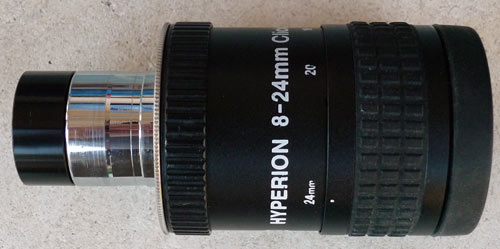
However it worked very well (both on the Optolyth TBG 100 and Pentax PF100), and as the Baader Zoom has a wide angle at maximum power (about 70º), the zoom with the 1.6x barlow can be a good and economical alternative to the Pentax XW5 (same magnification and field at maximum power of the zoom), with the bonus of wider field at lower power zoom positions - I was waiting for a Ethos 5mm 100º from TeleVue, or clones from other brands, but the zoom with the barlow maintain wider fields at lower magnifications... I tested resolution of the combo and it's similar to the one of Pentax XW5 (see it at Magnifications vs. resolution) but the Pentax maintains better light and colours (when compared to the zoom+barlow at 8mm position which results in 5mm but is visible a bit of colour aberration at this position on the Optolyth - didn't tested on field conditions with the Pentax). Nowadays I preferably use the zoom+barlow instead of the XW5, since it allows better fields for scanning for marked birds - I have to test this barlow in a new eyepiece to confirm colours and image quality since the tested is a home repaired one. The use of this barlow is also a way of the Baader zoom reaching focus on Pentax scopes and it doesn't affect the aesthetics of this brand scopes.
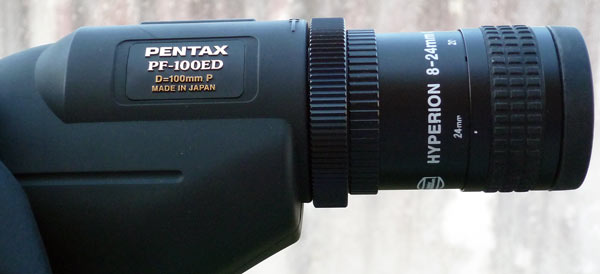
Is interesting that Leica and Kowa decided to use similar systems for their scopes, apparently with great image quality (I want to test them...), and I hope that other producers will follow them - Swarovski produces a 1.7x extender for the X models but is a different system.
Test of
image erectors
for astro-telescopes
(original text from 2008. Updated on 21-08-12
with the Nikon FSA-L2
improved; and on 31-01-2021 with the Omegon Pro
improved)
Astronomical
telescopes are well known by their potential to work at high powers for sky
observing but have limitations on their use in terrestrial day light use,
since originally their views are reversed up-side-down and also inverted
left-right. Star-diagonals correct the vertical inversion but the resulting
image still is inversed on the horizontal, left/right, which is not good for
cr-birding and also star diagonals are 90º (Televue have a 60º one), that
result not comfortable. Baader produce a good 2" erecting prism but
it's also a 90º. Questar produces also a good image erector but it only
works with their telescopes attachment and increases an additional 1.5x. The
available 45º prisms degrades the image to much at >70x magnifications.
Since I want to test bino-viewing and birding scopes do not work with
current bino-viewers (due to lack of sufficient in focus range - e.g.
http://www.birdforum.net/showthread.php?t=61124), I came back to my old
Celestron C5 (from 1994...), and tried to find new image erectors. I found
the Siebert one, also the Vixen and remembered also
to use my Optolyth photo-reflex adapter (needed an
adapter from T to 1.25"). All these solutions are straight viewing, which is
what I prefer. In the case of the Siebert, as it is a prism to put inside
the astro eyepieces, as a filter - I had to use a male 1.25" part of a
Celestron eyepiece and a 1.25" female (holder) from a Celestron barlow,
since was not possible to use in other way with the zoom (this solution was
also better when using a Celestron Ultima 30mm since vignetted less).. For
this test I used a Optolyth 20-60x zoom of the 100 model (31.75-10.6 mm),
with the adapter to use it in astronomical telescopes, which results in a
39-118x zoom in the C5 (1250 mm). The following photos show the several
combinations - look only for the field of view since the colours and
brightness depends on the auto settings of the camera:
- without any image erector - image erected in the computer to make easier to compare fields;
- with the Celestron 45º prism;
- with the Vixen image erector - it should be lens and not prism;
- with the Siebert prism;
- with the Optolyth photo image erector;
- the TBG100, to show the field at 20x - nest of Ardea cinerea included as a bonus... :-)












I already had noticed that without prism the image was much more bright but only now I noticed that it also result from a additional increase in the focal length of the telescope when using an image erector - it's not only more glass with the image erector...
The Celestron prism is ok for low powers but not suitable for high powers since make focus of the details impossible, as I already knew...
The Vixen allows correct focus at high powers, maintaining a light level similar to the Celestron prism, although probably increasing magnifications a little bit more. Only not so good detail is that is long - 14.3 cm - the C5 looks at least a bit strange... The refractors, that are already long, will be even longer... This might be a limitation for bino-viewing since will increase even more the complete set, although it's robust enough. An important quality is that it can be used in all telescopes since don't need to move focus range - it even focus in the Pentax PF100...
The Siebert prism maintain also the fine focus at high powers but vignettes a bit (much more in a Celestron Ultima 30mm), and, more important, it decreases the light too much. The main advantage is the compactness;
The Optolyth photo erector (also lens, as the Vixen), allows also fine focus at high magnifications and preserves light availability. It increases magnifications more, which can be limiting. This solution can also be done with the Nikon photo erector but needs more adaptors (at least an extra reducer ring). It might be a economical solution for those who already have these photo adaptors, otherwise the Vixen is a better and more economical solution.
As conclusion the Vixen is the solution for those who want to have terrestrial viewing from an astro telescope, preserving the ability of using high magnifications without focus or image quality problems. I wish that it would be not so long and not induce a 1.5x increase on magnifications... The ideal would be a solution of the length as the one I "built" for the Siebert. Also for refractors a 2" erecting solution would be better, and I can imagine the fanatics of wide fields using 2" wide angle eyepieces for terrestrial viewing!!! This would also be useful for the 2" bino-viewers and since only Siebert produces these, why not them to develop a good straight 2" image erector - a barlow like I did please...
In the case of the C5, besides the use of a 6.6 focal reducer, the reducing of the length of the 1.25" eyepiece holder will also reduce magnifications - this will allow wider fields. Also for bino-viewing this will help since in this telescope magnifications will increase 3x.
When testing the 5mm eyepieces in the resolution charts I tested the C5 with the Vixen and the mentioned Optolyth zoom and it obtained the best score with 1600 on the on the EIA1956 (maximum) and a score of 2-3 in scale 2 of the USAF1951 bar chart. Will test the solution in field on a study area where ducks are at bigger distances, to see if it results more efficient than the Optolyth, but for now astro telescopes should return to be a solution for cr-birding at high distances.
Other possible high quality erectors for astro-telescopes are the erector of the Kowa LensScope system and the eyepiece modules of the Swarovski STX, ATX or BTX eyepiece modules but would need special adapters and the costs are high.
During 2009 I found that the increase of power induced by the Vixen erector is higher than I expected since is in fact around 1.5x with eyepieces!!! Vixen publicity never mention it... After finding that it increased 3x when using a binoviewer I started to search for an alternative. When I saw the Nikon FSA-L2 for reflex digiscopy with the new EDG telescopes I thought of using it as an image erector (as the Optolyth equivalent worked and also the FSA-L1...), and has it doesn't induce increase of magnification at lower power (it works as a sort of 3.5x zoom), I expected that it also wouldn't induce increase of magnifications when working as image erector with eyepieces. After finding the pieces needed to use it on astro-telescopes (the easier way I found was to use T connections, so in one side a female Nikon F-mount to T and on the other a male Nikon F-mount also to T. For using astro-eyepieces is needed an adapter T to 1,25" or T to 2"). So the good news are that it works and has excellent image quality and it works both with 1,25" and 2" eyepieces - on this last one it vignettes on the C5 but it doesn't on the ED80/600 or on the TMB 92/506.

As I tested it with a 30mm 2" UWA (>80º), that has almost the largest field possible with 2" eyepieces, this means that fanatics of wide angled eyepieces can use this solution, even with a TV Ethos 21mm/100º and having a 3.5x zoom!!! For 1,25" eyepieces it can even reduce power about 0.95x. For 2" it seems to induce a bit of increase in magnification that could be solved by reducing the length of the 2" barrel piece, so getting closer the lens of the eyepiece to the ones of the FSA-L2. Besides the high cost, the other not so good details are that is long and for binoviewing it still induces a 2x increase... It isn't also parfocal when zooming.
Since it worked well I decided to improve it by removing the Nikon male F mount piece (of the camera side - it doesn't damage the chip for Nikon cameras), and asked Brightstar http://www.bstar-science.com do produce a piece with male T. Like this the 30mm 2" UWA is parfocal along the 3.5x zoom and the minimum position doesn't induce extra magnifications. On the other hand the 1.25" see magnifications reduced to 0.77x - using an extender you can find a position where there is no change in magnifications and the zoom become parfocal. With the Baader Mark V binoviewer the actual increase is about 1.7x.
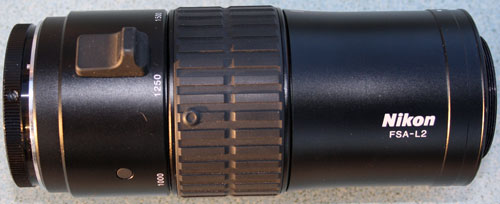
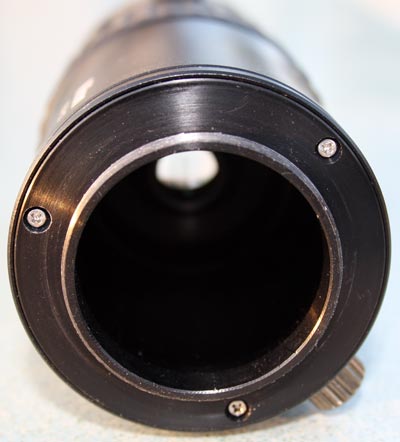
As the 30mm 2" UWA doesn't work well with the fast F5.5 ratio of the TMB92 (it shows too much field curvature), I tested the combo with a 17mm TV Nagler type 4 but this eyepiece shows blackouts during day use and the eye-relief isn't good enough for a eye-glass user like me. So I had to choose a 22mm TV Nagler that has better eye-relief and no blackouts during the day. The result is a 23-81x parfocal zoom with 82º AFOV! The resulting image quality is very good but I would prefer the 30-104x zoom range of the 17mm ep for cr-birding, if it worked well. Tested the BS 1.6x barlow with the 22mm, but it vignetted at lower power. So found a similar barlow but 2" (a GSO produced, sold with several brand names), that resulted on 1.44x increase factor so results on a 33-116x zoom. The image quality still is good but the field became a bit too much curved to allow a well focused area to read the codes in >50% of the field.
Meanwhile I had a opportunity of testing an Ethos 17mm with this combo and, surprise or not, the image quality still is better than with the Nagler 22 and, although I don't manage to see the all 100º AFOV at the same time, I can see about 90º with my eye-glasses! See in the photo bellow how it looks like! See more combinations and resolutions.
Omegon Pro (last update 29-12-2024)
Since the Nikon FSA-L2 doesn't work well with the lens module of Swarovski X95 I searched for another solution that would result on good image quality, would be more compact than the Vixen erector and wouldn't induce any increase factor. I found the Omegon Pro but since I had to order some adapters, I thought of making it compatible with binoviewers and refractors. Ordered 3 pieces adapters - see bellow - telescope side has 2" barrel and eyepiece side has T2 - the middle one is a 2" tube made of hard plastic.
Before and after bellow: - the original version has lenses at the 1.25" section that should result on an increase factor about 1.5x - the version with the adapters doesn't induce magnification increase!...
It's possible to use 2" eps and a Nagler 22 doesn't vignette. Using it with binoviewers, it's possible to reach focus at the infinite inserting all erector inside of the refractor!
However, I would prefer that Omegon would produce a day-light version of this erector, with no dark coatings (it's visible the loss of light, although the image quality is excellent even at very high magnifications!), and without the need of these adapter pieces - those interested can send me an e-mail since I have some extra spare pieces that I ordered...;-)
It still doesn't work so well with my Celestron C5 - I have to test some details but it's not my priority...
Test of 82º, 92º, 100º and 102º AFOV zooms (updated on 14-06-2016)
As the Nikon FSA-L2 works well with 82º and 100º eyepieces (see the previous upper paragraphs and photos), I organized in the following text the information from tests I did to compare several solutions that work well.
The Ethos17 deals very well with the field curvature of the TMB92 showing a completely flat field for the resulting zoom of 30-96x - I noticed by measuring the TFOV that, with complex eyepieces like this, the zoom factor of the Nikon FSA-L2 is inferior to 3.5x, having in this case a zoom factor of 3.2x. This flat field allows the use of the 2" barlow cell that results in a increase factor of 1.36 to 1.29x (over 1250mm the first lens of the FSA-L2 start to be closer to the barlow cell reducing the increasing factor - the global zoom factor result on only 3x), maintaining a very good image quality that allows the reading of codes at >85% of the field. The resulting magnifications and resolutions are summarized at the following table that also show the Nagler 22 values that result on a zoom factor of 3.3x with the FSA-L2, but the FSA-L2 also increases 8.3% the magnifications when used with the Nagler 22 i.e. is equivalent to a 20.3mm eyepiece (the Nagler is another complex eyepiece...). At the same day I obtained the following results with the Optolyth 100: 30x - 2 (scale 0) on USAF1951, 400 on EIA1956; 90x - 1 (scale 2), 1000-1100.
|
Eyepieces/Magnifications /Focal Distance /true FD |
Nagler 22mm (82º) | Ethos 17mm (100º) |
Ethos 17mm
(100º)
+ 1.36-1.29x barlow |
| 500 /506 | 25x; 1 t(scale 0); 400 | 30x; 1 to 2 (scale 0); 400 | 41x; 1 (scale 1); 700 |
| 1000/<1000 | 47x; 2 (scale 1); 700 | 57; 4 (scale 1); 800 | 76x; 6 (scale 1); 1200 |
| 1500/<1500 | 72x; 4 (scale 1); 900 | 87x; 6 (scale 1) ; 1200 | 112x; 2 (scale 2); 1400-1600 |
| 1750/<1750 | 82x; 6 (scale 1); 1000-1200 | 96x; 1 (scale 2); 1200-1400 | 124x; 3 (scale 2); 1400-1600 |
I prefer the Ethos17 version with the barlow cell (in the following photo), since it increases the eye-relief a bit, allowing me to see 85 to 97% of the field of view (with and without rubber eyeguard, respectively), as opposite to 82 to 90% of the Ethos17 without barlow - don't forget that I use eye-glasses - but also found that the Nikon FSA-L2 increases the eyerelief at the minimum magnifications since without it I only can see 55 to 62%, respectively. So now I have a 41-124x zoom with 100º AFOV, being that the TFOV is bigger than with the Optolyth 100 - at minimum magnification is +70% and at maximum magnification is +16%, even with the +37% magnification increase!!! By the way with only the Ethos 17, the increase in fields are +130% and +50%!!! - this version is more interesting when the higher magnifications aren't needed and we can benefit from it's larger field of view. I should also inform that, although the factory field stop of the Nagler 22 is wider than the Ethos 17, with this combo I verified that the Ethos 17 has a bit wider TFOV than the Nagler 22 (as I told before the Nagler results in an equivalent 20.3 mm eyepiece with the FSA-L2). Higher magnifications are possible inserting T spacers between the FSA-L2 and the barlow - using a T spacers with 17mm the resulting magnifications with the Ethos17 are 48-144x!
These results made me to think if would be better to have a 12.5 Nikon HW eyepiece since would not need the barlow (so with better image quality), once it is supposed to have better eye-relief than the Ethos, and the resulting magnifications could be higher, after the minimum zoom position, and might result in higher resolutions besides having 102º AFOV... It took me some months to obtain one and the following photo shows how the combo result.
In practise the HW showed to have lower useful eye-relief for eye-glass users than the Ethos+barlow cell combo since the rubber eye-guard induces higher loss of eye-relief than the one of the Ethos. Also, even without the rubber eye-guard there is no better eye-relief. Regarding magnifications, the resulting FSA-L2 zoom factor is about 3.4x, being that this combo has wider TFOVs at minimum magnification and the same at higher magnification (although the 2º AFOV difference seem higher...), but the useful fields with glasses are more reduced than with Ethos17 + barlow solution. More problematic is that the HW deals less well with the field curvature of the TMB92 so isn't possible to focus all field at once...
When testing the 2" barlow cell with the HW, to verify if there was an increase on eye-relief, I noticed that the field curvature of the TMB92 was no longer a problem (the barlow corrects it...), so did a practical test to verify If I would prefer the views with the HW12.5 + barlow cell or with the Ethos17 + barlow cell + spacer, for having similar minimum magnifications. I seem to prefer the Ethos combo views due to better eye-relief with the rubber eyecup but the HW combo has higher resolutions, has better eye-relief without the rubber eyecup and it doesn't scratch my eye-glasses (unlike the Ethos, without the rubber eyecup). The following table compares the resolution of the 48-144x 100ºAFOV zoom to the 53-178x 102ºAFOV zoom !!! At minimum magnifications de TFOV are similar... At the same day I obtained the following results with the Optolyth 100 (with the 1st version of the compact zoom): 30x - 4 (scale 0) on USAF1951, 600 on EIA1956; 90x - 6 (scale 1), 1200.
|
Eyepieces/Magnification /Focal Distance /true FD |
Ethos 17mm
(100º)
+ 1.36-1.29x barlow |
Ethos 17mm
(100º)
+ spacer 1.61-1.5x barlow |
HW 12.5mm
(102º)
+ 1.30-1.29x barlow |
| 500 /506 | 41x; 1 (scale 1); 800 | 48x; 2-3 (scale 1); 1200 | 53x; 3 (scale 1); 1400 |
| 1000/<1000 | 76x; 1 (scale 2); 1400 | 89x; 2 (scale 2); 1600 | 99x; 2-3 (scale 2); 1600 |
| 1500/<1500 | 112x; 2 (scale 2); 1600 | 130x; 3-4 (scale 2); >1600 | 158x; 4 (scale 2); >1600 |
| 1750/<1750 | 124x; 3 (scale 2); >1600 | 144x; 4 (scale 2); >1600 | 178x; 5 (scale 2); >1600 |
Before having the HW12.5, I thought of using a HW17 with the barlow but unfortunately this eyepiece most probably wouldn't be parfocal when zooming the FSA-L2...
On early 2016 ES released new eyepieces - the 92 series, with 92º AFOV and eyerelief suitable for eyeglass users like me. So I ordered a 12mm to see if it works well... It does and the look is:
Be aware that the FSA-L2 increases the eye-relief and to avoid black-outs and be more comfortable I added the rubber eyecup of a XWA5 over the original folded down... Now I'm testing a 42-146x equivalent zoom, that at minimum power have larger true field than the Swaro 95!
For wider TFOV but lower magnifications / resolutions there are the Ethos 21, the ES100 20 (at Cloudy-Nights forum the ES100 25mm isn’t recommended for daylight use. If you use eyeglasses, the ES100 20mm isn’t recommended since has less eye-relief than the Ethos…), and on 82º there are the Nagler 31 and the Celestron Axion 31 – although still not tested the Nagler 31, it’s assumed as one of the best eps of this focal length. I tested the ES82 30mm, that didn’t work well with my material (too much field curvature and distortion...), and tested the Celestron Axion 31 that worked great – see how it looks on the following photo!
If was today, I would purchased it for testing it on digiscopy since the image was completely flat and well corrected, the useful eye-relief and brightness were high and the resulting zoom range would be 16 to <= 57x... This made me think that the Celestron Luminos 23mm could be a good economic alternative to the TV Nagler 22 but I tested and it didn't result parfocal when zooming with the Nikon FSA-L2 and the image quality wasn't as good as with the Nagler 22!...
Test of my present preferred cr-telescopes (updated on 09-05-2020)
On early summer of 2015 I got a Swarovski X95 and started to use it to see if it's more efficient that my favourite cr-telescopes. As its maximum magnification is only 70x and I previously did a short test where my Optolyth 100 had higher resolution, I forced my self to get used to it on my duck nasal saddle resightings. I reached some conclusions that I want to share. The photos bellow show the length of the different combos:
If length is visible, I must add the weight of the different combos, with the same Manfrotto plate: Swarovski X95 - 2313g, Optolyth 100 - 2670g, TMB92 - 5254+1390=6644g!!!...
One of the advantages of the TMB92 combo is the wide FOV and is also one of the plus of the Swaro X line. So I decided to show how it looks behind each scope. First, on the left, is the TMB92 combo, second the Optolyth 100 with the compact zoom, after the Optolyth 100 with the Baader zoom, and the last on the right is the Swarovski X95. First row of photos show AFOVs at 30x (26x with the Baader), second at 70x (79x with the Baader and approximate for the others. The Swarovski X95 should have true maximum magnification of 72x...), and the last row is at 96x and 90x (TMB and Optolyth).
The difference in AFOVs are visible except for the TMB combo where there are extra AFOVs that weren't captured by the camera... At 30x, the TMB combo has about 10 fence spaces!!!.. At maximum magnification the TMB combo has about 5 fence spaces!
It's obvious the reduced AFOV of the Optolyth zoom at lower magnification. The pincushion distortion of the Ethos17 from the TMB combo is not noticeable when cr-birding.
In terms of image quality the Swaro X95 is superb, being the sharpest of all and with greater contrast - the TMB is almost as sharp being that the extra AFOV suggest even better contrast then it really has, but is has the best colours, being totally free of Colour Aberrations. From my practical experience during the last months the Swaro X95 best the others for resighting until 220m, being the most efficient. As the zoom and focus wheels are close that makes the operation faster than the others and explains the higher efficiency, combined with the larger AFOVs (compared to the Optolyth). Will do a table with resolutions in the future, when will have time, but if the Swarovski 95 reached 90x it would be the "dream cr-telescope"... It could be accomplished by increasing the zoom factor to 3x i.e. producing an improved eyepiece module. Swarovski released a 1.7x extender on early May 2017, the resulting zoom should be 51-122x) and see the end of this section how well it performs.
I would like to test a recent sample of a Optolyth to see if coatings improved but this test made me to finally order a new Baader zoom, to better compare it to the X95, since the zoom I had was a home repaired one with much dust inside and it also "passed away" when doing the tests - I was also delaying this purchase hoping that a astrozoom with large AFOVs would be released...
For fanatics of fixed wide angles, good samples of the Optolyth 100 or the Pentax PF100 can be economical alternatives to the Swaro X95, if paired to the right eyepieces:
- these with a Meade 5000/60_26 (seem being cloned by the ES62_26, being that the ES is waterproof and can have updated coatings. Both result on 24x) and the Pentax XW20 (resulting on 31.5x), have larger AFOV and TFOV than the X95 at 30x - see photos bellow (from left to right): - X95 at 30x, Optolyth 100 with Meade 5000/60_26 (>17% TFOV increase), Optolyth 100 with XW20 (only 0.5% TFOV increase but with 70º AFOV). The use of a Baader Hyperion 24mm would produce 26x, with a TFOV similar to the Meade 26, with an AFOV similar to the XW20!...
- compare the AFOV of photo of the X95 at 70x and the one of the Morpheus 4.5 at the Test of 5mm astronomical eyepieces, or of the Nikon...
Kowa could produce a >=95mm telescope that would benefit of their wide zoom, the 1.6x extender and could also be used with fixed wide AFOV astro eyepieces... :-)
Zeiss released the Harpia 95 with internal 3x zoom and a 72º eyepiece that result on a zoom of 23-70x, that has the focus and zoom rings close, as on the 95, and see how it compares to the X95.
As told at Test of 82º, 92º, 100º and 102º AFOV zooms, with the release of ES92 12mm, now I'm using a 42-146x equivalent zoom with 92º, that at minimum power have larger true field than the X95! The TMB combo increased 350g for a total of 6994g...
This combo became one of my preferred solutions for distances higher than 220m. Other is the Optolyth 100 with the Baader zoom and the 1.6x barlow (the weight increased to 2851g, mainly due to the higher weight of the Baader zoom, when compared to the Optolyth compact zoom). At >220m, Luis Arede prefers the Pentax PF100 with a Televue zoom and the 1.6x barlow - he used the PF100 combo for more than 2 years and during one year the X95 (without the extender). Since 2018 I use the Swarovski 1.7x extender, that results on a 51-122x zoom on the X95, maintaining the Swaro high image quality and I use it for resighting marked birds at >220m. The extender only weights 184g and in the photo bellow you can compare it with my other preferred solutions for >220m cr-birding - even with the showed digiscopy adapters the X95 continues to be lighter - 2564g.
Swarovski X95 vs Zeiss Harpia 95 - a biased contact
The Swarovski X95 is my present CR-telescope reference and during 2019 Zeiss released the Harpia model that also has a 95mm version. On late September I had a opportunity to do a short contact with the Zeiss Harpia 95 and to compare it to my Swarovski X95 at the store of Birdlife Sweden, the Naturbokhandeln at the island of Öland, where is also the Ottenby Bird Observatory - what a great place to be at!...
When doing the test the X95 had also the sun-shade extended since the Sun was on the diagonal in front, left side. As the Swarovski X line the Zeiss Harpia has the zoom and focus wheels close that makes the operation faster than with the traditional scopes. One of the advantages of the Zeiss Harpia over the Swarovski X95 is that has constant 72º AFOV and has an internal 3x zoom, with magnifications from 23 to 70x - lower magnification and wider AFOV means that there is a huge difference on TFOV to the X95 at lower mag...
This makes easier to find a bird (and to make counts), but the Harpia has aperture limitation until 40x, being that at 23x has less light (works as a <65mm scope) than the Swarovski X95 at 30x - the above photos where taken with center light measuring, with camera on auto - the Harpia 95 photo was taken at 1/100 second - f/7.1 - 100 ISO ; the X95 photo was taken at 1/125 second - f/8.0 - 100 ISO - this means that at dusk the X95 is better then the Harpia 95 and that probably the same would occur for digiscopy - to be confirmed in a real test... Over 40x the aperture limitation disappears and light gathering is no longer a limitation, being that the X95 also recovers AFOV to 70º- see bellow at maximum magnification...
At the centre of the field, the Harpia 95 had a bit better definition than my Swarovski X95 and 2 other observers confirmed this and "preferred the colours" - I'm used to the X95 colours and didn't noticed a significant difference.
However at the limit of the field the Harpia suffers from image aberrations (not field curvature since isn't possible to focus it... The other 2 observers confirmed it also), being that at the higher magnification position, the Swarovski X95 has similar total AFOV but better useful, AFOV where is possible to read CR-codes - I took some photos to try to show this but failed... One more thing to do during a real test, with more time...
For resighting marked birds at >220m the Swarovski X95 has the advantage of having the 1.7x extender that increases resolution at greater distances, due to the zoom range of 51-122x. The Swarovski X95 can also became a BTX using the binomodule but can't zoom. The Harpia reach focus with astronomical eyepieces (read post 11 at https://www.birdforum.net/showthread.php?t=374682 or read the Chinese written test at https://mp.weixin.qq.com/s/xEsClpbmTXXZFvencfnGDA), but there is no commercially available adapter - when it will be available, users can use many different astroeyepieces, allowing higher magnifications and even wider AFOVs, being that image quality can even improve (read link at birdforum - the X95 can use also astro eps...). If there was a straight version of Harpia I probably would be tempted on getting one and produce an adapter to use 1.25" eps - for my CR-birding conditions I prefer straight view scopes that are more practical...
One Harpia design detail that might be unexpected is the equivalent short focal lengths that induces the "need" for "aperture limitation" at magnifications lower than 40x, on the 95 version, that didn't occurred with the Zeiss Photoscope. For me the reason is that is easier to produce a binoviewer option to replace the eyepiece. With a 2 to 2.6x OCS is probably possible to adapt a binoviewer that focus and results on similar magnifications - using a 2.6x OCS with a binoviewer with a pair of Baader Morpheus 17.5mm would result in magnifications from 25.9 to 77.7x with 76º AFOV! If I didn't have already my binocombos and the Harpia had straight versions I would try to reach a solution like this!
I don't know if Zeiss still plans to release a binoviewer for the Harpia or gave up due to costs and/or dimensions...
Swarovski X95 vs X115 (11-11-2024)
This is a question that CR-birders might have in their mind and the photo bellow illustrate my summary thoughts (will detail more when possible):
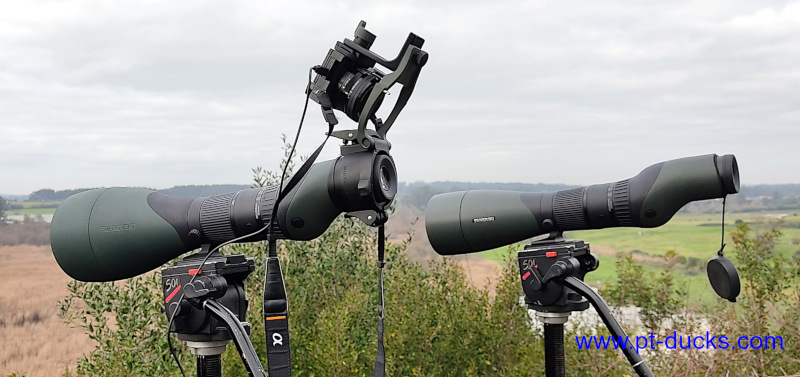
- the X115 has better glass (show almost no Colour Aberration) and more light than the X95, that is ideal for digiscopy and better for low light conditions;
- the X115 is more expensive and heavy than the X95, but now the X95 seems a "small" scope...;
- I compared the X115 with the X95 on field conditions, both with the extenders and side by side, resighting nasal saddled teal at extreme distances (>220m...), and didn't saw improved resolution... Later found that the more recent STX eyepiece module (serial number HA1122732A), that came with the X115, had a wider zoom range (2.1 to 2.6% - mean 2.3%), being that, considering the same AFOVs, the lower mag is lower 4 to 4.5% (mean 4.3%), and the maximum mag is also lower 1.9% - that aren't compensated by the X115 having a 0.81 to 1,3% longer focal length than the X95 (mean 1.05%), i.e. the resulting true magnifications were lower on the X115 than on the X95 I was comparing to... I kept the more recent STX eyepiece module since is nice to have larger TFOV, to scan for marked ducks, and the X115 can have better resolution, that might compensate the marginally lower maximum magnification - there is no other 115mm top level spotting scope!...;
- The X115 show Spherical Aberration (SA), that isn't noticed on the X95 (but also has been observed on the Kowa 99 versions...), and should reduce potential resolution. However, at least 2 reputable observers found higher resolutions on some X115 than on the X95, and I'm guessing that the SA of the X115 might be a sign of future release of eyepiece modules that will "extract" all potential of the X115 - as explained at Swarovski X derivations - I found that the X lens modules are built to be corrected by the X eyepiece modules...
I have to replace the STX95 by the STX115 at my preferred cr-telescopes...
So, if money and weight aren't limitations for you, get a X115! If you already have a X95, don't want to spend money and/or don't want to carry more weight, you aren't loosing much by not updating to the X115.
With the BTX, the benefits of the X115 might be higher.
Swarovski X derivations (updated on 02-05-2021)
The Swarovski X95 is one of my preferred cr-telescopes but had a limitation of only allowing 72x as maximum magnification before Swarovski released the 1.7x extender on 2017. I though of replacing the TMB92 on the combos with higher magnifications and wider AFOVs by the X95 lens module, to gain weight, dimensions, field-flatness and internal focus - it is equivalent to a 560mm refractor. It took me some years to find someone to produce the adaptor but I managed to do it and it's a 2 piece adapter very easy to apply and remove. It has a bayonet system, on the telescope side, and T and 2" males on the other side, that allows to use all T and astronomical 2" material.
The resulting combos look nice...
And is even possible to use 0.85x focal reducers...
However, if large AFOVs, beautiful colours, ultra-flat-fields and high magnifications are obtained, there is a lack of resolution specially visible at high magnifications... :-(
It's possible to use a binoviewer and focus through all 3.5x zoom range but the lack of resolution persists.
After testing other combinations of material I found that the use of the Vixen image erector produces high resolution images, although loosing some field-flatness, being usable even with 5mm eye-pieces that should result on >132x magnifications!
As the Vixen erector works also as a barlow (increases 1,18x with a Baader Hyperion Zoom Mark III), it allows the use of an Ethos 17 without vignetting...
Will test it on field and will update this after doing resolution tests.
With the release of the X series, I thought that the lens modules could be used for astronomical observation and here is a photo of the X95 with a low-cost diagonal prism and the Baader zoom.
I must mention that when I took the STX photo, the fence and scale were in the shadow and I had to auto-equilibrate colours...
Some of you, that only do birding, might be thinking, so what?
The photo on the left is from a UW80º 2" eyepiece with 30mm (the ep with wider field of view that I have - there are much better corrected similar eyepieces but much more expensive...), without diagonal since I don't have a 2" one. It's visible the much wider TFOV!...
On the right is the photo with the Ethos17 - the camera couldn't capture all field of view - see Ethos photos and explanation at Test of my present preferred cr-telescopes. The resulting image quality using the low cost prism diagonal seems much better than those resulting with the FSA-L2 combos... One of these days I have to spend some time looking to the sky at night and compare it to the TMB92...
On 2018 I found a compact straight image erector that produces high quality image with the X95 but had to order custom adapters to make it even better... It's the Omegon Pro (before having the adapters I had to replace the 1.25" barrel nosepiece by a short piece without lens - I replaced by the Baader Hyperion Zoom 1.25" barrel (until the version MKIII - not sure if the version MKIV is similar...)) - it produces sharp images even at high magnifications - 119x with 110º - see bellow (before having the adapters...)!
It can receive 2" eps without vignetting including the Ethos 17 - result on 34x with 100º AFOV!
Lower mags can be obtained with a Nagler 22 - 28x with 82º AFOV! Better eye-relief for eye-glass users like me and similar FOV. The photo bellow show already the Omegon erector with the adapters.
It's possible to use a Siebert PMW using a Baader 1.25x GPC between the X95 and the image erector, resulting on a sort of zoom - with the ES_92 12mm results on 60-102x (see bellow) - it would be better to use a ES_92 17, that would result on more usable mags - 42-72x. Both with 92º AFOV - I call it ETX!
Using a TS 2.6x GPC is possible to use a straight binoviewer but the combo bellow still results on too high mags - 72-140x... However I will test other material combos that I expect to result on more usable mags! A X115 would be better to my DTX version... ;-)
More at https://www.birdforum.net/threads/x-derivations.334364/post-4509935
Test of 5mm eyepieces (updated on 20-11-2016)
I use astronomical eyepieces to increase maximum magnifications of spotting scopes, since many years. On 2008, I tested 2 low cost high power eyepieces of good quality against my reference - Pentax XW 5mm. On 2012, I added a TeleVue Nagler 5mm (82º) and tried to reach a similar power with a 100º AFOV eyepiece - see after the present test. Since then, was released a TeleVue Ethos 4.7mm with 110º AFOV, but the high cost and the reduced eye-relief induced me to not try to get one without testing one. Meanwhile were produced some clones of the Ethos 4.7, not so expensive, so I decided to try one to see how the 110º look!... Also got a Baader Morpheus 4.5mm since it has 76º but has a good eye-relief, that was supposed to be enough for eye-glass users (it's the wider AFOV eyepiece of 4.5-5mm probably suitable for eye-glass users). Also added the Nikon HW 12.5 with 2 BS 1.6x barlows that result in a equivalent to 4.5mm, with increased eye-relief that allows to see >85% from the 102º AFOV of this eyepiece... See how these look:
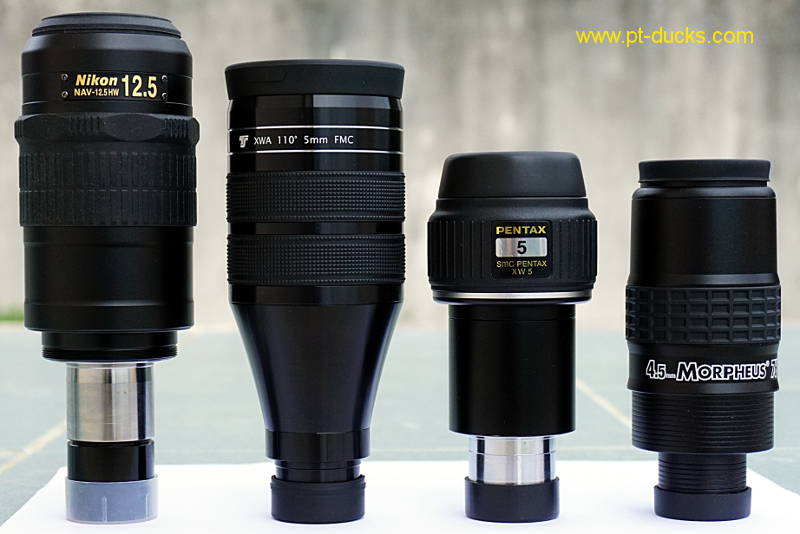
The table bellow shows their details:
| Nikon HW 12.5mm+2BS | TS XWA 5mm | Pentax XW 5mm | Baader Morpheus 4.5mm | |
| Measured Weight (g), with caps | 686 | 614 | 416 | 359 |
| Fact. AFOV (º) | 102 | 110 | 70 | 76 |
| Eye-relief (mm) | >16 | 15 | 20 | 17.5 |
| Magnifications x | 140 | 126 | 126 | 140 |
| Cost (euros) | 1290+80 | 240 | 369 | 245 |
| Res. USAF1951 | 2-3 (scale 2) | 2-3 (scale 2) | 2-3 (scale 2) | 2-3 (scale 2) |
| Resolution EIA1956 | 1600 | 1600 | 1600 | 1600 |
| Advantages | very wide field of view, suitable for eye-glass users |
Lower price, very wide field of view without eye-glasses |
Waterproof, Infinitely adjustable eyeguard, eye-relief |
wide field of view, suitable for some eye-glass users |
| Disadvantages |
price, "darker image", length |
Reduced eye-relief - about 60º useful with eye-glasses |
price |
no infinitely adjustable eyeguard |
The following images show the AFOV for eye-glass users - same order of the table above.
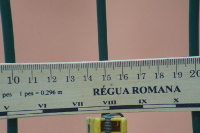
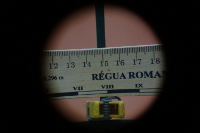
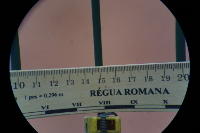
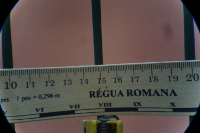
The test was made during a cloudy day and might be a reason for the resolutions being similar with all eyepieces - will test again in a sunny day. Unlike I was expecting, there was no big light decrease on the Morpheus compared to the XW5 and the true field of view is similar. The Morpheus is a good solution for some eye-glass users but probably not for all - I have to press my eye-glasses against the eyecup to avoid blackouts... The Nikon SW5 and the TeleVue Delos 4.5 have similar quality and specifications to the XW5 and the Morpheus 4.5, but are more expensive in most countries.
As expected, the XWA5 isn't suitable for eye-glass users but I was surprised to find that I obtained the same resolutions without eye-glasses and benefiting from the "window effect" of the 110º - it has more 32% of true field of view than the XW5!... It's a big eyepiece but looks good on a PF100...
Some people don't like the XWA5 large eyecup but I found it ok, although I agree that it could have not so big diameter and have a format more like the XW5, but it shadows the exterior of the eye-piece and reduces light from the environment. There are Ethos clones with similar eyecup of the Ethos - if you don't use eye-glasses and price is no problem to you, choose an Ethos that has superior quality and is the original model, not the copy... XWA5 owners that are not happy with the eyecup can replace it with the winged eyecup of the Baader zoom MarkIII that are available for purchase.
The XWA5 is the model that needs less infocus so is the eyepiece that will reach focus on more spotting scopes. The XW5 is the model that needs more infocus and doesn't reach focus at the infinite with the Zeiss 85 - the XWA5 and Morpheus do on the latest version.
The Nikon HW combo seem to have less light available due to the extra lenses of the barlow cells but the definition if very good. I need field use to conclude on my preferred!
Since this test, I found an alternative that I prefer to the Nikon HW combo: - I got an Explore Scientific 12 mm of the series with 92º AFOV, that has eye-relief suitable for eye-glass users, and added a Baader zoom 2.25x barlow to reach an equivalent 5 mm. It's needed also a 2" to T ring adapter and a T to 1.25" male adapter (beware that it must be one with all interior with 1.25" filter female thread). This combo is more comfortable than the HW combo, has more light availability and, although bigger and heavier, isn't as expensive as the Nikon HW. Will update this test replacing the HW combo by the ES92_12 combo but see how it looks in a PF100...
Test from 23-05-2012
I used a 9mm TMB100º with a BS 1.6x barlow (used one filter cell as extender reaching an equivalent of 5.2mm. On the PF100 was possible to use a second filter cell resulting on 5 mm - on the Optolyth this solution didn't reach focus...). The eyepieces were tested in the Optolyth TBG100 and the Pentax PF 100 (not the last 2 eps). Test was made after 5pm, with both telescopes and charts in the shadow.
| TV Nagler 5mm | TS Plan. HR 5mm | Baader Hyp. 5mm | Pentax XW 5mm | TMB100 9mm+BS | |
| Measured Weight (g) | 225 | 174 | 410 | 412 | 420 |
| Fact. AFOV (º) | 82 | 60 | 68 | 70 | 100 |
| Eye-relief (mm) | 12 | 16 | 20 | 20 | 12 |
| Magnifications x | 126 | 126 | 126 | 126 | 121 |
| Cost (euros) | 258 | 59 | 109 | 369 | 298+40 |
| Res. USAF1951 Optolyth | 1-2 (scale 2) | 1-2 (scale 2) | 1 (scale 2) | 1-2 (scale 2) | 1-2 (scale 2) |
| Res. USAF1951 Pentax | 1 (scale 2) | 1 (scale 2) | 1 (scale 2) | ||
| Resolution EIA1956 Opt. | 1100-1250 | 1100-1250 | 1250-1400 | 1250-1400 | 1250-1400 |
| Resolution EIA1956 Pen. | 1100-1250 | 1100-1250 | 1100-1250 | ||
| Advantages | Low weight and dimensions, wide field of view |
Lower price, Infinitely adjustable eyeguard, low weight and dimensions |
price, eye-relief |
Waterproof, Infinitely adjustable eyeguard, eye-relief |
very wide field of view |
| Disadvantages |
Reduced eye-relief and pincushion distortion |
Reduced field of view |
no Infinitely adjustable eyeguard |
price |
Reduced eye-relief, kidney bean effect |
The result table show that both TS and Baader eyepieces have good image quality, being good low cost alternatives to the Pentax XW. One detail not possible to evaluate is the durability and resistance of the coatings of these eyepieces. Also not objectively quantifiable is the fact that the XW goes very well with the Optolyth coatings, increasing light without compromising contrast. TS and Baader increase the contrast in the PF100 but reduce light a bit in the Optolyth. Although having a good eye relief, Baader eyepiece is not so comfortable for eyeglasses users since there is no finer eyeguard adjustment. There is a APM UWA eyepiece 5 mm 70° that seems to have a similar system of Pentax.
TS eyepiece eyerelief can be limiting for some eyeglass users and the reduced angle of view makes much more difficult to find/follow cr-birds (8 or 10º seem a small difference but the result is completely different).
The TV Nagler 5mm is the less user-friendly eyepiece, due to the reduced eye-relief, being difficult to find a comfortable eye position. In the case of eye-glasses users, like me, the reduced eye-relief is even more problematic since only allow a useful AFOV of about 60º... It also shows pincushion distortion that is more problematic in birding than in astro use.
The TMB100 is the cheaper and more compact of the existing 100º AFOV eye-pieces models. It's reduced eye-relief results from a bad conception of the rubber eyeguard that induces a loss of 2-3mm of eye-relief... For eye-glass users the TMB100 only allow about 70º useful AFOV, being that we must move the head to see the remaining field of view. For non eye-glass users it's a good alternative of the 82º eyepieces since are more comfortable although this model only allows the viewing of about 85º AFOV at the same time because if the eye becomes closer to the lens (to see all 100º), kidney bean / blackout effect appears in day-light use - to see the remaining field we must move our eye...
On May 2012 I managed to do a short test with an Ethos 3.7mm on the Optolyth100 but the result was disappointing since the eye-relief is too short - with glasses I can only see <50º AFOV, besides the problems the excess of power problems you can read in the following paragraph.
In 2008, I also tested the Televue Radian 4mm - it confirmed my field experience, with these 630mm focal length scopes of 100mm aperture, that there is no gain on resolution by using a 4mm eyepiece (compared to a 5mm), and there is a great loss in field of view and light availability. On scopes of 80mm aperture with lower focal length this might be not true.
Test of Zoom eyepieces (last update 29-12-2024)
Zoom eyepieces are a "must have" for CR-birding - you use low magnification to detect the marked bird and then zoom to read the code. Top spotting scope producers produce also high quality zooms, being that the more recent models have wide field of views. Unfortunately Optolyth and Pentax zoom eyepieces aren't the best, also in terms of Apparent Fields of Views (AFOVs). As mentioned at Test of my present preferred cr-telescopes, I use a Baader Hyperion Zoom MKIII (24-8mm - BZ) on the Optolyth 100 to obtain better image quality, wider AFOVs (48-68º) and True Fields of Views (TFOVs) - is easier to find and follow the marked ducks. During 2022, APM introduced a SuperZoom (15.4-7.7mm - APM), with 66º constant AFOV, but unfortunately doesn't reach focus on spotting scopes. However, can be used with astronomical telescopes for birding. During 2024, SVBony introduced a SuperZoom (20-8mm - SVB) that is advertised with having 57-72° AFOV - this reaches focus on the Optolyth 100 (on the Pentax PF100 might reach focus - on one sample that has problems with prism collimation, it almost reach focus at lower magnification and reaches at maximum magnification), and produce wider TFOV than the Baader and APM zooms.
The SVB isn't taller than the APM and in the focuser becomes shorter:
But it has the larger diameter eye-lens:
On the Optolyth I compare the Baader and the SVBony:
The SVB has more 24.4% of TFOV at 20mm than the BZ at 24mm, and more 14% at 8mm:
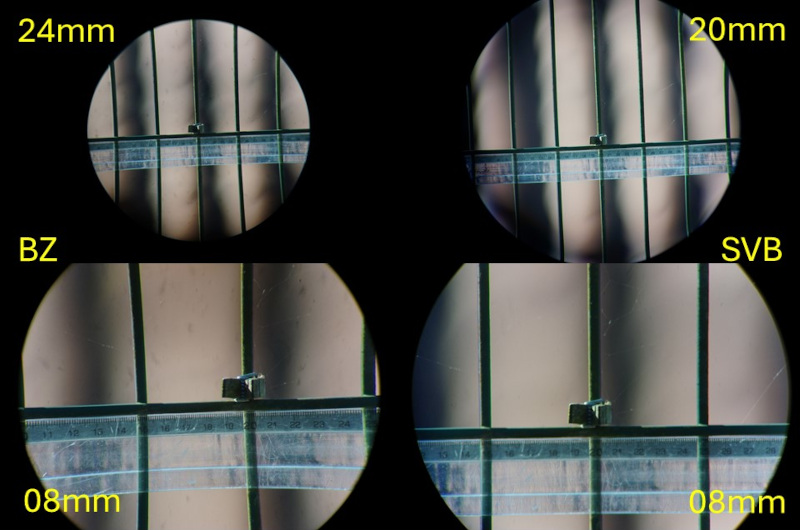
However, if the SVB is 8mm, the BZ should be 7.5mm...
The AFOV of the SVB is a bit smaller than the one of the Swaro X115 at 30x but is larger at maximum magnification!
On the TMB92 I compared the 3 zooms:
The APM has 12-13% larger TFOV at 15.4mm than the BZ at 24mm (more 35-36% than the BZ at 16mm!), but less 2-5% at 7.7mm than the Baader at 8mm (result of lower focal length and 66 vs 68º...).
The SVB has more 20-22% of TFOV at 20mm than the BZ at 24mm (more 26-28% than the BZ at 20mm, and more 7.2-7.5% than the APM at 15.4mm but less 5.2-5.4% at 16mmm), and more 12.3-14.1% at 8mm (more 17-19.2% than the APM at 7.7mm) - see photos bellow showing the AFOVs/TFOVs differences, including the X115 at 30 and 70x (last version of STX, that has larger FOVs). The SVB at 20mm has more reduced eye-relief and that is visible on the photo - forgot to do the photo at 16mm...
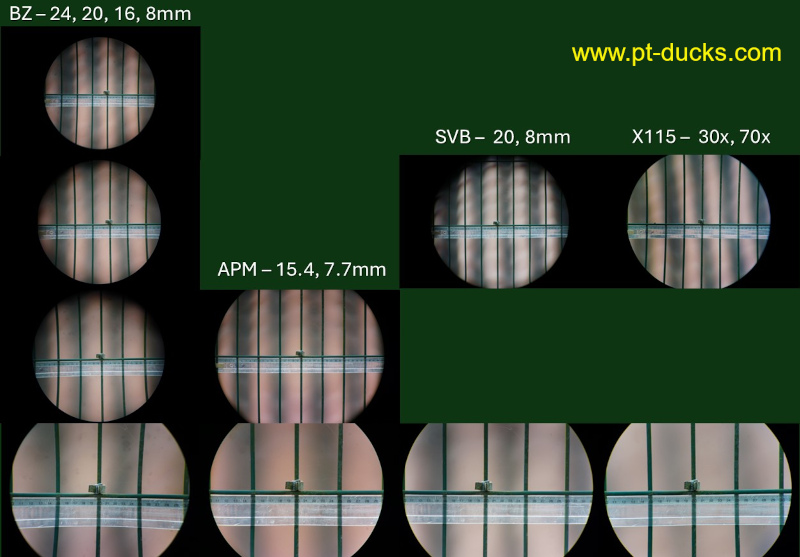
The TMB92 with the SVB compares to the X115 in terms of AFOVs (slightly less at minimum mags but slightly larger at maximum!), and has larger TFOVs.
The SVB and the APM can be considered parfocal when zooming that the BZ isn't - needs about 1.5mm focus travel from maximum to minimum magnifications.
The rubber eyecups of both the APM and the SVB induce loss of useful eye-relief for eye-glass users, like me, but both can be replaced by the Baader Morpheus eyecup (see CN for the case of the APM), being that result perfect on the SVB - see previous photo! The BZ can also receive the same eyecup but will induce loss of eye-relief.
The APM seems to produce the best image quality (seems to have the best coatings - the SVB seem to have "dark" coatings...), when zooming there is no movement of the exterior lens on the telescope side (the other 2 move and that's probably the reason why I already see some debris inside the Baader...), can receive directly the Baader Hyperion 2.25x barlow cell directly (results on a 6.3-3.2mm zoom), but needs more 27-28mm infocus than the SVB zoom (the SVB needs less 1mm infocus than the Baader), that can cause focus problems with some astro telescopes and doesn't allows to reach focus with spotting scopes, as already mentioned. The APM has a bit more eye-relief than the SVB (I don't compare with the Baader since the eyecup that is more eye-glass friendly was lost and isn't sold separately...), but the SVB is better to avoid black-outs during the day.
The SVB will be the zoom used both with the Optolyth and the TMB combo, but the APM has "something special"!
For binoviewing, the SVB requires the larger Inter Pupil Distance (IPD) >=60mm, that might be limiting for some - is my case... The APM is the zoom that needs less IPD - 55mm
Will include more photos, information and tests when possible...
Test of 15x56 binoculars (22-04-2017. Canon 18x50 IS information at the end, added on 11-11-2024)
Within certain site conditions, resightings of marked birds can also be done with binoculars. As I do many hours of resighting in a hide close to ducks and I almost managed to read duck nasal saddle codes with my old Leica 10x50, that induced me to move to 15x56 binoculars. I purchased a Swarovski SLC 15x56 during the late nineteen's, it allowed me to resight nasal saddles until 30-40m and it was my cr-binocular until recently. With the purchase of a Leica Geovid15x56 I compare bellow both binoculars.
As I use eye-glasses, I couldn't see all FOV of the Swarovski and it was one of the reasons to choose to purchase the Leica (it also has a telemeter - allows to measure distances...). See the specifications in the table bellow - the useful FOV was estimated using eye-glasses and comparing to the TFOV of the Swarovski, without eye-glasses.
| Model | Swarovski SLC 15x56 (old) | Leica Geovid 15x56 |
| Weight (g, with caps and strap) | 1530 | 1395 |
| Length (mm) | 205 | 208 |
| AFOV º | 68 | 65 |
| FOV (1000m) | 78 | 75 |
| Eye-relief | 13 (16 new model) | 15 |
| Useful FOV EG (% from Swaro) | 81 | 94 |
| Minimum focus (m) | >7 (3.9 new model) | 5.9 |
| USAF1951 | 6 (-1) | 6 (-1) to 1 (0) |
| EIA1956 | 500-600 | 600-700 |
| Cost € | 2100 (new model) | 2350 |
I couldn't measure light transmition but the Leica has more light and contrast that results in a more 3D image and slightly better resolution (measured with bino stabilised over a tripod - not attached to it). The Swaro image shows a yellowish tone.
The upper images show the Swaro on the left and the Leica on the right, with my Sony a6000, at 16mm zoom (images only resized). On the top is the normal view without eye-glasses. Below is the eye-glass users perspective - it was obtained inserting a rubber ring to reduce the usable eye-relief - I concluded that the eye-relief difference is higher than the 2 mm obtained comparing the producers information!
I must inform you that my Swaro is needing maintenance (some dirty on inside lenses...), and that there is a new Swaro version - I recently looked through one and all AFOV is visible with eye-glasses. I will update this test when I will have a chance to compare the new Swaro model but meanwhile I'm finally sending my for maintenance - I don't need it since the Leica is my new cr-binocular!...
I also would like to up-date this test including the Canon 15x50 IS model since I was convinced with the Image Stabilization on the 10x42 model... However, I went for a Canon 18x50 IS since I expected to be even better for my CR-birding...
Since I use eye-glasses, I had to do some "bricolage" on the Canon eye-cups, to be able to see all AFOV, and I have seen the "light" of the Image Stabilisation - IS - use! IS reduces image shake from our body involuntary small movements, increases resolution, therefore allows codes to be seen much further away!!! To read codes at higher distances with the 15x56 binoculars, I had to stabilize de image by supporting the binoculars on hide structures - it's no longer needed with IS and IS do produce better stabilization!
When I will have time, I will write a proper comparison test.
If you don't use hides often (where you can help the IS by supporting your elbows on the hide structure), the Canon 15x50 IS might be better.
Resolution charts (24-04-08)
From reading several posts at http://www.birdforum.net/forumdisplay.php?f=286 I decided to start using resolution charts to try to standardise tests and better allow comparing different materials. Charts were obtained also through some posts of the same link, being that the EIA1956 chart was printed in the original dimensions but the USAF1951 bar chart had to be printed in landscape with adapting size to allow the total printing (in portrait I didn't found a printer that printed all chart detail...). Test was done with the chart at 32.5m from telescopes and the distance will stay the same for future tests. On the USAF1951 bar chart is not visible the 2 scale group but has lower dimensions then the 1 scale group visible in the centre of the chart. On the EIA1956 I considered the middle group of lines as going from 800 to 1600 (one side goes from 200 to 400, the other from 400 to 800). The curved field of the photo is only the result of the lower zoom position of the photo camera...

Magnifications vs. resolution (04-06-10)
I'm always searching for higher useful magnifications and I know that the increase on resolution isn't directly proportional to the increase in magnifications. I remembered to measure the resolution of several possible magnifications - see resolution charts. For that I used the same telescope (Optolyth TBG100) and just changed eyepieces.
| Magnifications - eyepiece | USAF1951 | EIA1956 |
| 20x - Optolyth 20-60x/100 | 6 (scale -1) to 1 (scale 0) | 400 |
| 25x - Baader 24-8mm | 1-2 (scale 0) | 400 |
| 60x - Optolyth 20-60x/100 | 3-4 (scale 1) | 800 |
| 75x - Baader 24-8mm | 4-5 (scale 1) | 800-900 |
| 90x - Optolyth 20-60x/80 | 6 (scale 1) | 1000 |
| 97.5x - Pentax XF 22.5-6.5mm | 6 (scale 1) to 1 (scale 2) | 1000-1200 |
| 126x - Pentax XW5mm | 1-2 (scale 2) |
1000-1200 1200-1400 (PF100) |
| 126x - Baader 24-8mm +barlow 1.6x | 1-2 (scale 2) |
1000-1200 |
If you compare this values with the ones of Test of 5mm eyepieces you will notice that some values changed - this might be a result of different light and atmospheric conditions, some dust in the Optolyth ocular hole (this time the Pentax PF100 had slightly better results than the Optolyth) and/or different eyesight - it varies along the day and within days and I also changed lens of eyeglasses... Interesting also to note that I obtained the same resolution values with a Nikon ED78 with the zoom, both at 25x and 75x.
CR-binoviewing (updated on 14-09-2017)
Viewing with both eyes is much more comfortable than with only one eye. Also resolution increases since 2 eyes can resolve more detail than one. The problem is that there aren't binotelescopes, with maximum magnifications over 50x, that are practical to use for cr-binding. Since there are binoviewers for astronomical telescopes I thought of using them with normal birding telescopes but that is not possible.
Swarovski released the BTX module on early May 2017 that incorporates a binoviewer but has fixed magnifications of 30x for the X65/85 and 35x for the X95, that can be increased adding the also new 1.7x extender, resulting on 51x for the X65/85 and 60x for the X95, and with 2 extenders 87x for the X65/85 and 101x for the X95. For CR birding has some limitations but I could use one BTX for a couple hours on field and compared it to my preferred binocombo - see To BTX or not to BTX?
After testing various solutions (see CR-binoviewing tests), I reached a practical solution with good Image quality and high resolution (see table below - at the same day I obtained the following results with the Optolyth 100: 30x - 2 to 3 (scale 0) USAF1951, 400 EIA1956; 90x - 6 (scale 1) to 1 (scale 2), 1000).
|
Eyepieces/Magnifications / Focal Distance/true FD |
40 mm Vixen NLV (43º) | 32 mm TS SuperView (52º) | 25 mm TS Planetary HR (60º) |
| 500 /860 | 21x; 1 to 2 (scale 0); 400 | 27x; 2 to 3 (scale 0); 700-800 | 34x; 1 (scale 1); 800 |
| 1000/1720 | 43x; 1 (scale 1); 700-800 | 54; 3 to 4
(scale 1);
1000-1100 |
69x; 6 (scale 1) to 1 (scale 2); 1200 |
| 1500/2580 | 64x; 4 to 5
(scale 1);
800-1000 |
81x; 6 (scale 1) to 1 (scale 2); 1200 | 103x; 2 (scale 2); 1400-1600 |
| 1750/3010 | 75x; 5 to 6 (scale 1); 1000-1200 | 94x; 1 (scale 2); 1400-1600 | 120x; <= |
The resulting combination of material is not short nor light but the image quality and the confort of viewing compensate it. I usually used the HR25 since have wider AFOV and better resolution - the true field of view is similar within all tested eyepieces, for each focal distance i.e. at 103x the HR25 have almost the same field than the NLV40 at 64x (see the last pargraph of this section). Also at minimum magnifications I have a wider field of view with this combo than with the Optolyth100 with the zoom at 30x.
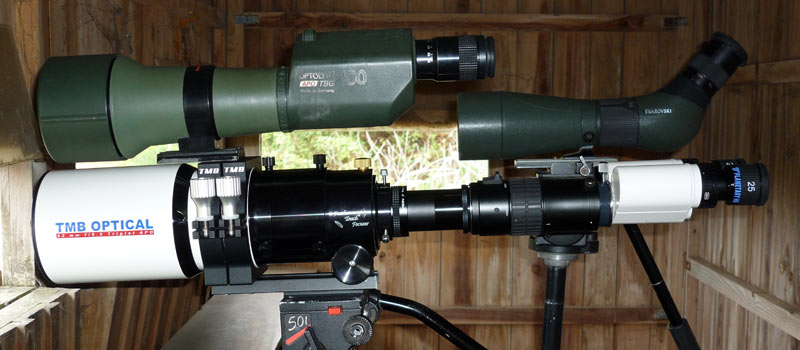
Compared to a normal telescope, I just have to additionally mount the erector+binoviewer+eyepieces combo on the telescope so it takes just a few seconds more to mount it on the tripod. In the case I also take the pair of TS Superview 32mm for situations where light conditions aren't good. If the transport case would be few centimetres shorter it would be easier to transport in my cars (note that also did a bit of bricolage with the box foam...).
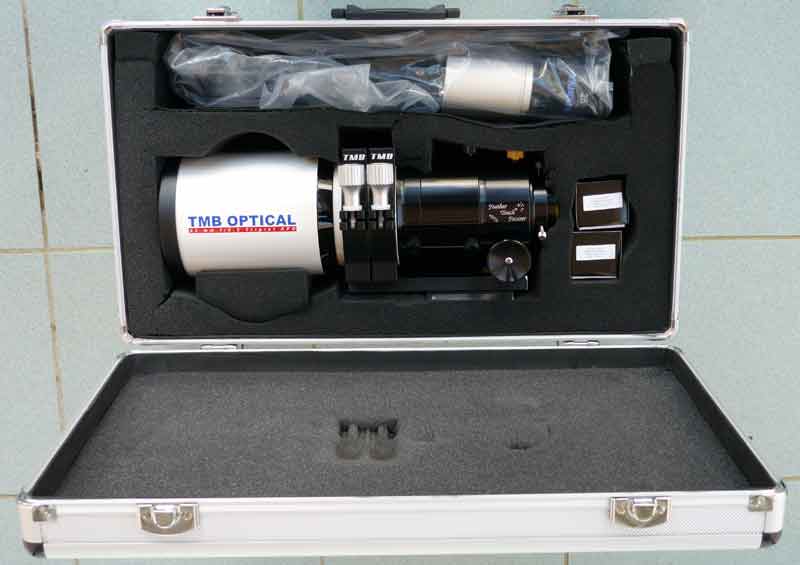
I had a chance to compare the combo with a Swarosvki 80 HD with the 25-50x zoom and I prefer the views through the present bino-combo - 2 eyes and the higher magnifications are another dimension of cr-birding!!! For birding the same is true since the "bino effect" is increased with closer distances.
The summary is that views are great (seeing birds at close distances we enter in a new dimension of birding!!!) and comfortable, the minus are the dimensions and weight, and that I must refocus when zooming.
In the more recent material combination I replaced the HR25 by a pair of Meade 5000/60º 26mm since found that these last ones result in a flatter field of view - see the end of the following CR-binoviewing tests. Also found that the zoom factor of Nikon FSA-L2 is reduced when using this last combo (3.25x, probably also the above ones), being the resulting magnifications of 33x, 65x, 95x and 107x (at similar FSA-L2 positions of the anterior table), and the resulting resolutions similar to the ones of the Ethos17 with the barlow, on monoviewing, although with the bino-combo the light availability is a more limiting factor.
More updated information available at CR BinoBirding.
I could use a Swarovski BTX with the X95 for a couple of hours in one of my CR-birding areas and I could compare it to my STX and to my preferred binocombo.
I can start by stating that the BTX has 2 limitations for my CR-birding use: - it's angled (I prefer straight view...) and doesn't zoom... That said, the BTX has all advantages of binoview that I already mentioned and the advantage of being a factory designed solution, with Swarovski quality standards!...
Comparing the BTX views to the STX, side by side within the 95 version, on normal light conditions the BTX looses a bit of contrast and sharpness but that's only noticeable side by side. To compensate this the increase of resolution perceived with the BTX is also noticeable. What I didn't expected, and was a good surprise, is that when looking to a water channel that was overshadowed by willows (about 1 hour before sunset, with clear sky), the BTX showed better contrast and crisper views than my STX!... If others will corroborate that (I don't know when I will have access to another BTX...), this will be a plus for those birding on lowlight conditions and eventually for those doing astronomical observations.
Comparing the BTX to my preferred bino-combo, it's visible that the BTX wins on TFOV and on image quality, but by small margins - I should add that the photo quality of the TMB combo probably suffered by higher eye-relief that I didn't totally compensate by turning out the eye-cup. I congratulate Swarosvski by the quality of the BTX (there is no polarising effect within both ocular sides and no ghost images at all!!!), but was more pleased to see that my bino-combo has almost the same image quality and can zoom (besides being straight view), that is fundamental for my type of birding. I will return to my bino-combo and will invest on enlarging the TFOV and testing larger AFOV eyepieces - with the release of the Swarovski 1.7x extender I think that my 92º and 100º monoview solutions will be not so much used and I can take the bino-combo to fieldwork instead... ;-)
As mentioned at Swarovski X derivations, it's a pity that use of the X95 lens module with my bino-combo material doesn't produce high image quality results, specially when zooming, since I would prefer to use it instead of the TMB92...
CR-binoviewing tests (updated on 05-02-2012)
As binoviewers for astronomical telescopes don't reach focus on birding telescopes, I turned to my old C5, that with the Vixen erector lens has high quality image. As 24-8mm zoom eyepieces result in too high magnification on this telescope (52-156x), I though of using the Siebert PMW for of 0.6-2.5x (result similar to a 4.2x zoom). However I only received a 1-3x PMW and then I had to replace the 1.6x element by a 0.5x element, resulting similar to a 6x zoom! As I read on the web that one of the problems of binoviewers were that can induce increase in magnifications I had to choose one that allowed to use the maximum field of traditional 1.25" astroeyepieces. So I opted for the Baader Mark V, considered one of the best, and that is European made (easier to send to repair - binoviewers are considered not much robust...). Regarding the eyepieces I wanted the maximum field of view and not too much magnifications with the C5, so I chose a pair of Vixen NLV 40mm, that also have twist eyecups, important for those like me that must use eye-glasses. After testing several solutions with focal reducers, the best solution I tested was using a Brightstar 0.5x focal reducer before the image erector and the PMW from 1 to 3x. The result combo is a bit long and strange - see it compared to an Optolyth 100...
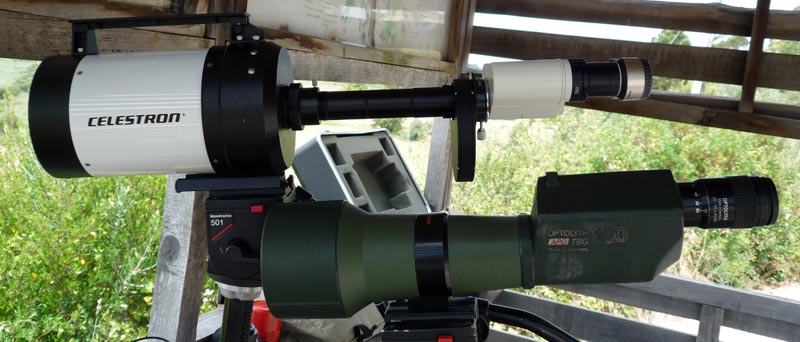
Regarding the image quality, it's not much good at 1x since the field is too much curved and the central obstruction of the C5 becomes visible. Other magnifications are sharp but lacks a bit of contrast, compared with the image resulting from the use of the same setup without any focal reducer. The main problem is that this solution still have much high magnifications - see the images below resulting from (1x, 2x, 2.5x and 3x, on the left), compared with the Optolyth 100 with the 80mm model 20-60x zoom that result in 30-90x (on the right at 30 and 90x). I should mention that the same combo without the focal reducer produces high quality images but with too much high magnifications, so not usable due to reduced field.
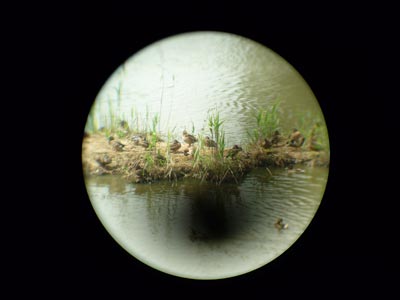
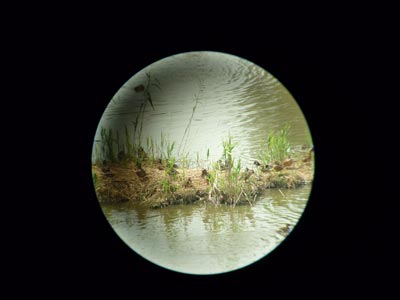



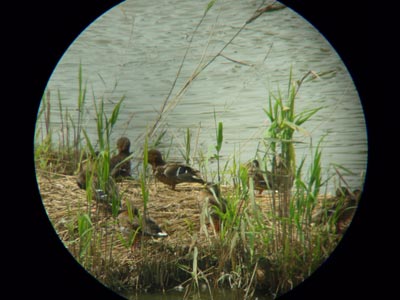
As I found that the use of the binoviewer with the Vixen erector lens result in an extra increase of 2x (3x!, in total, compared to the use of an eyepiece without both bino and erector), I tested the combo in a 600mm ED80 Celestron/Skywatcher (thanks Pedro http://celestron80ed.blogspot.com/). The 0.5x focal reducer can not be used due to lower focus range (never focus). In the opposite of what I read before, with the Vixen erector and a binoviewer, the problem is not lack of in focus but lack of out focus. This limitation was solved by using 2 Brightstar T extender rings. The resulting combo is even longer (the image below is also longer due to the use of the objective protection).

If the combo compactness is not good, the image quality is incredible good, for the resulting magnifications, and I never had so nice high power views - looking with the 2 eyes is really a big plus. However, the high magnifications was again a problem because reduces the usable field. So I have to find a <=500 mm apo-refractor, eventually with a 0.8x reducer.
Since the Nikon FSA-L2 resulted in the best image erector I tested and works as sort of 3.5x zoom, I thought I could use a Nikon telephoto lens as an scope. I tested it in a 300mm/2.8 (thanks Loureiro http://joseloureirophotography.blogspot.com/), that resulted in the more compact solution I tested - see photo below.
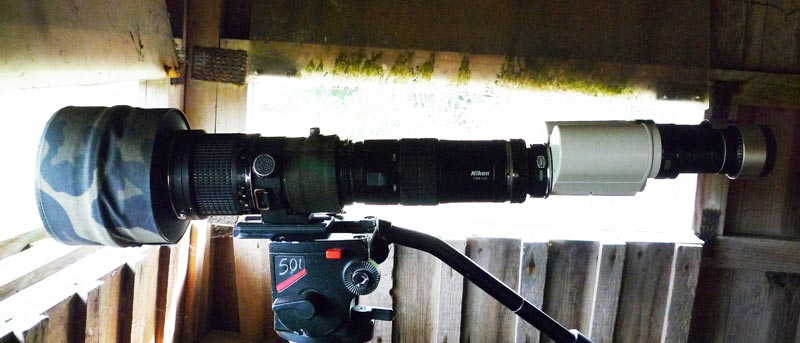
However the result isn't the best because the image quality suffers from lack of contrast and isn't possible to use all zoom range since the focus range of the lens isn't enough - back to an astro-refractor solution.
I opted for the TMB APO triplet 92/506 with two eyepieces Meade 5000 26mm/60º. With this combo (still big and more heavy...), I can do cr-binoviewing with larger fields than my Optolyth 100 with the 30-90x zoom, being that I'm working with magnifications from 40.5 to 142x!!!
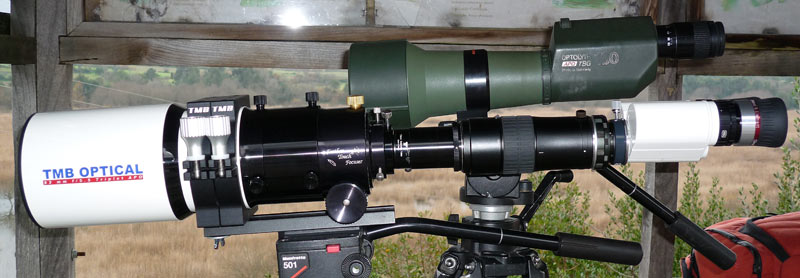
However I detected a lack of resolution at high power (the Optolyth at 126x has better apparent definition) that I thought that might be a problem of not perfect collimation of the telescope (It spent too many time travelling...) and/or the binoviewer (It felt down accidently from 1.6m...). However I did a star test and all things are collimated - the Baader bino proved to be robust!!! After replacing the lens cell things improved much. I also found that the Meade 5000 26mm/60º eyepieces induces aberrations with this combo so returned to the Vixens that resulted on 26-92x. With the improvements made on the Nikon FSA-L2 the resulting magnifications were reduced to 21-75x with the Vixens 40mm. This mean that I have to find another pair of eyepieces - something between 32 and 24 mm - the advantage is that I will have better AFOV.
After searching the market for eyepieces that could be used and that have regulation of eyeguard (I use glasses), I ordered a pair of 32 mm Teleskop Service (TS) SuperView (52º) and a pair of 25 mm TS Planetary HR (60º). These models have Infinitely adjustable eyeguards that are better then the Vixen system that only have 2 positions. Also the SuperViews eyeguards have bigger adjustable distance than the Vixens - the NLV40 have high eyerelief and users without glasses can find the longer position of the eyeguards too short to hold a comfortable viewing.
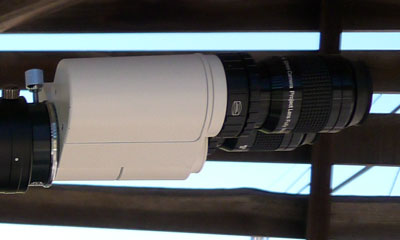
To improve contrast and image quality I added a light reducer black ring (made from plastic from a CD box... see image below), to only allow the entrance of light needed in the FSA-L2 - it seems to work when light is abundant.
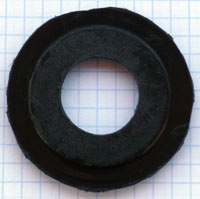
After this improvement the Meade 5000 26mm/60º also showed better image quality but is more difficult to find the best eye positions since my nose contacts frequently with the eyepieces - the TS HR are much smaller (and lighter...), so is much easier to find the correct eye positions and these are my preferred, even having a field slightly curved. In terms of true fields of view, the NLV40 and the Meades have the same value (in the Mark V), slightly bigger than the fields of the HR25 and SuperView32 (similar within both), but the differences are insignificant.
After noticing that the field of view with the HR25 is a bit curved I tested a pair of TV Panoptic 24/68º but the field still resulted curved and the reduced eye-relief didn't allowed to see all field. After re-testing the Meade 5000 26mm/60º I found that these resulted in the flatter field and the eye/nose position problems could be eliminated by not extending the eyeguards. The present combo now includes a pair of these instead of the HR25.
Questar User experience
I own a Questar 3,5 Field Model for more than 10 years, so I think I
can give you some field experiences. I do use the
Q only for bird watching and try to do some "ring" reading (neck-collars of
geese, swans and colour-rings of other birds including Cranes). The
eyepieces I use are the 32mm and 24mm; this gives enlargements of 40x and
53x respectively. Add to this that one needs the Image Erector for correct
right-left image, this adds an extra 1.5x factor. So with this combination
you have a 60x and 80x telescope. I have little experience with higher
enlargements; I have used on few occasions a Plössl eyepiece of 15mm (makes
ca. 130x), but the brand of this eyepiece was not up to the Questar-standards;
I only use it in extreme conditions.
Some advantages of the Q:
- very good (it is said the best) optical quality;
- one can use high magnifications in low light conditions with still very
good contrast and details;
- high magnifications can be used which are not possible with other
telescopes;
- very compact construction, certainly in view of the high magnifications.
Some minus points:
- smallest magnification is about 40x, so it is sometimes difficult to find
that 1 bird and it is certainly not suited for sea-watching
(too small angle of view) or for scanning large groups; it is also very
difficult to get birds in flight (so not very suited for p.e. raptor
migration);
- need of a very good and sturdy support;
- no zoom available, so if one needs a higher magnification you need to
unscrew (no bayonet) the eyepieces and then screw in the other; this causes
lost of time and especially with moving birds in a flock, one looses the
target.
- effect of "heath haze" (the movement of the air due to the heath) seems
to be bigger with the Q than with more traditional bird watching telescopes
(probably due to the mirror construction);
- very small depth of field (but extremely sharp) so one needs nearly
constantly readjustment of the focus;
- seemingly a vulnerable construction, but I did not have any problems with
it during those years of use.
Concerning the decrease in image quality with the Questar erector I am
quiet satisfied; I think the decrease is minimal. By using the image erector
I get a correct view (right-right/left-left); this is very important if one
wants to read rings (otherwise all letters would be mirrored!!!). I think
the Image Erector of the Questar is very good (also the price is high); but
it adds another magnification of about 1.5 times to the image: the erector
works like an additional converter (or Barlow lens, like the one build in
the star diagonal from the Q). OK you loose some brightness, but that is a
thing that is also inevitable with a higher magnification. Another remark,
on the image erector like the ones on a Celestron C5: in the Celestron-models
the eyepieces come in an angle of 45° with the image erector used, which is
much more comfortable viewing than when you use the star-diagonal of the
Questar: here you have an angle of 90° and that is a very uncomfortable
position for your neck!!! When the image erector is at 45° this is very
similar to the popular conventional angled telescopes.
By Mark Raes ( Marc.Raes add Pandora.be
)
David Rodrigues adding - on the Questar it can be
used also zooms. On the 1st CR-Birding
Meeting I tested the Televue zoom on it and it worked well. The only
potential problem is that it probably increases too much: 80-240x!!! It may
be difficult to find birds and light availability will be more problematic.
Nikon ED82 user experience
During the spring 2004 I bought a Nikon ED-82A with a 25-75x zoom. This was
after testing/comparing with the Zeiss 20-60x and the Optolyth 100.
The Nikon has a cool, blue view while the Zeiss goes 'yellowish'.
For me the 25-75x is really a great thing for ring-reading. Weekly I'm going
with a friend that has an Optolyth 100 with a zoom 20-60x for cr-geese.
Really the difference of maximum power of the zooms (60 to 75) makes the
difference on cr-birding.
By Dirk Raes ( raes.dirk add scarlet.be
)
Opticron ES100
user experience
I use it only for to read cr-rings of gulls, with 27-80x
zoom. Compared to Swarowski HD80 (20-60x) in ring reading it gives more distance (only during
"cold weather" of course). If I read Finnish rings (argentatus with small
codes>>5 digits>> Cxxxx), it gives about 30 meters more distance (about
180m>210m) specially at dark days. And in extreme cases I use 134x ocular to get
at least 30-40 meters more (>>250m, if no wind).
By Risto Juvaste (
risto.juvaste add kolumbus.fi
)
